Motor Mine Sweeper (MMS) 251
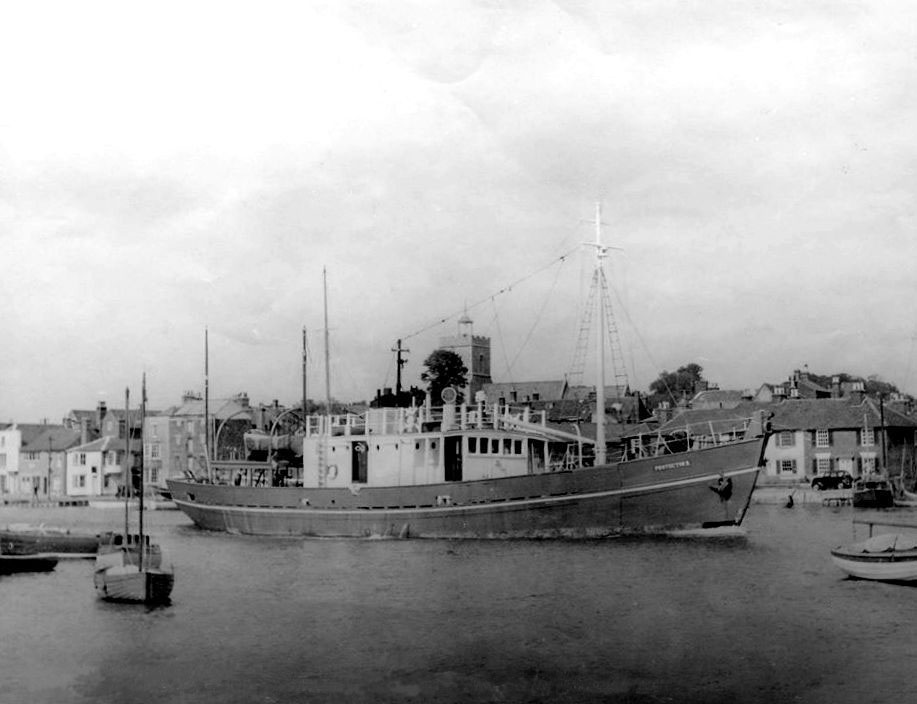
It is a small world and I am constantly amazed at the unexpected connections that sometimes crop up……I had posted the piece on Castalia, the wreck we stumbled across in the shallows at Weddell Island in the Falkland Islands, and thought little more about it, I had researched as far as I thought I could and that everything that could be found had been. It turned out not to be so and a Falkland Islands resident, Robert Rowlands got in touch to kindly correct some information and chat about the wreck and, very graciously, supplied some family photos of the wreck from his extensive archive. What has that to do with Protector III you might ask? Well, it turns out Robert also saw the piece on Protector III and, as his father had been Engineer of the vessel in her Sealing days around the Falkland Islands, Robert had some more information on Protector III to, again (very kindly), share with me. As you can see from the Picture Robert provided me (above), Protector III was built as a Motor Mine Sweeper (MMS), by Wagstaff & Hatfield of Port Greville in Nova Scotia, Canada
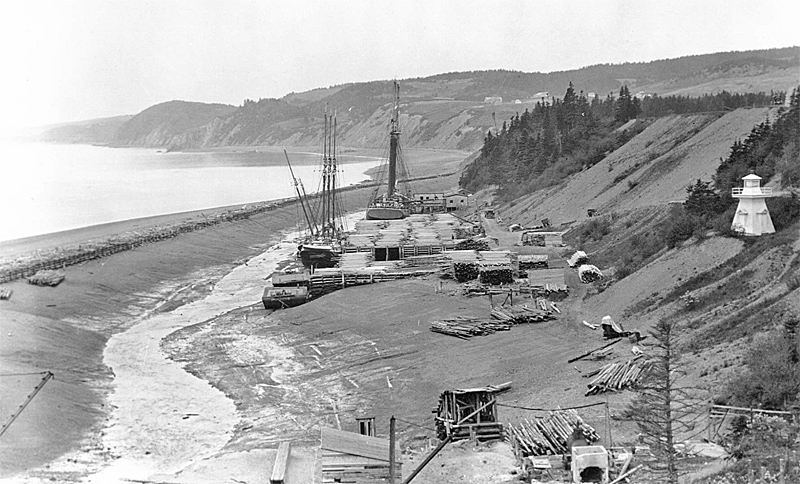
Wagstaff & Hatfield Port Greville Canada
George Wagstaff was born in 1887, his Father a shipwright, working at yards in Annapolis in the USA & British Columbia between 1902 and 1910. George joined his father as an apprentice in 1901 at 13 years old, until 1913 when he moved back to British Columbia, to set up his own shipyard, eventually settling in Port Greville around 1916 (Editorial “Timber to Tall Ships Our Parrsborough Shore, Wagstaffe & Hatfield Shipyard, 3”. Online Resource: https:// www. communitystories.ca / v1/pm_v2.php? id=story_line&lg= English&fl =0&ex=271&sl= 591&pos=1&pf=1 Accessed 20/12/2021). Otto Hatfield was a local, born in Port Greville, and joined Wagstaffe in 1933 to take over the financials, at which point the firm became “Wagstaffe & Hatfield Shipbuilding & Repairs”, Otto was variously, secretary, Treasurer, Office Manager and Purchasing Manager for Wagstaffe & Hatfield
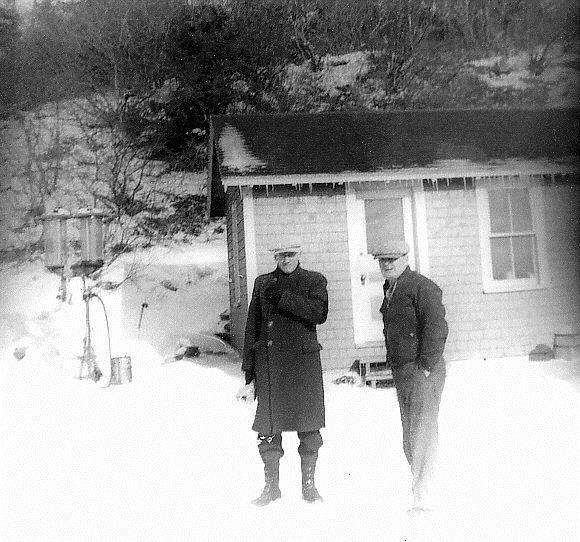
The Ratchford River flows into the Minas Basin, its mouth forming a gravel bar extending down the shoreline for a kilometer, subject to tidal flow, and making an excellent groyne. It was this gravel bar that offered a natural access to those early colonialists breaking into the huge wilderness of British Columbia and, by so doing, becoming the forefathers of modern Canada. In 1874, a wall of round timber, 2,200 feet in length and seven feet tall, had been constructed along the bar to provide additional protection, forming a makeshift harbour, George Wagstaff’s father viewed the gravel spit as a fitting place to set up a shipyard, and developed the river mouth into a more substantial and safe harbour. Another benefit was its proximity to abundant and varied timbers, ideally suited to the construction of sailing ships in the 1800’s. That timber was still available in plentiful supply when sailing vessels became steam and, eventually, diesel powered ships. The wooden hulls of early vessels such as these were ideally suited to small coastal minesweeping operations, having a much reduced magnetic and acoustic signature, limiting the effect of German magnetic and acoustic mines
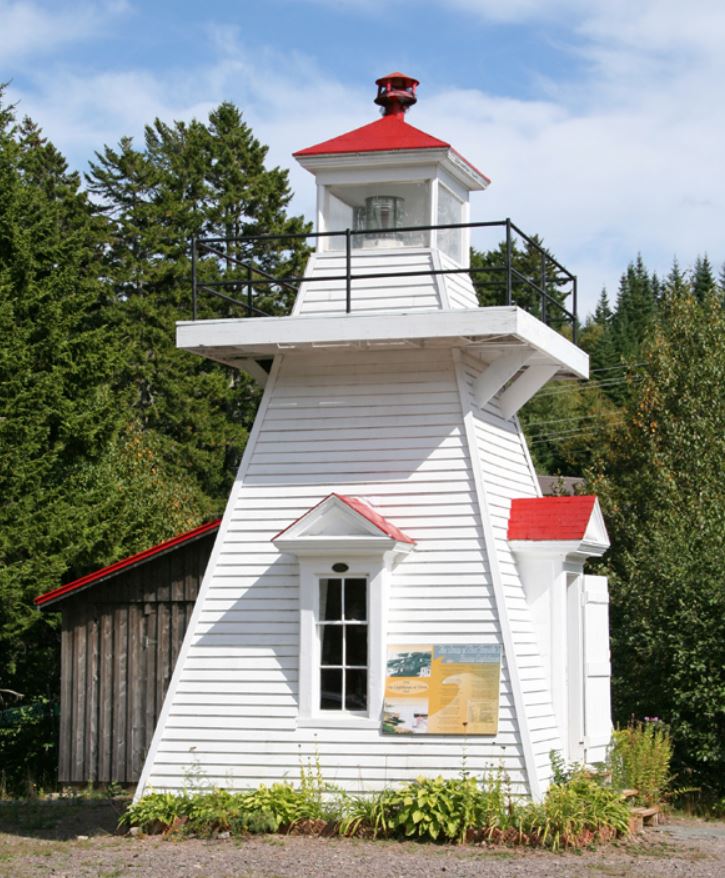
To better identify the harbour to shipping, in 1907, the Canadian Government had John Reid build a pair of “range lights” at Port Greville (Editorial “Port Greville Lighthouse” Online Resource: https:// www.lighthousefriends.com/ light.asp? ID=1016 Accessed: 25/12/2021), the eventual construction would be suitably prominent: “The tower is an enclosed wooden building, square in plan, with sloping sides, surmounted by a square wooden lantern, the whole painted white. The height of the tower from its base to the top of the ventilator on the lantern is 25 feet. The light is a fixed red light, elevated 59 feet above high-water mark, and should be visible 6 miles from all points of approach by water” Although Wagstaff & Hatfield Shipyard is no longer there, remnants of the time can be seen at the Age of Sail Museum in Port Greville, where a small and uniquely local collection hosts “…a museum in an 1854 church, local blacksmith shop from the Wagstaff and Hatfield shipyard, as well as the Port Greville Lighthouse circa 1908 and a boathouse”. In a perhaps not so strange a coincidence, the first lighthouse keeper, appointed on June 29th, 1908 was a Mr Ernest A. Hatfield, very likely a close relation of Otto Hatfield
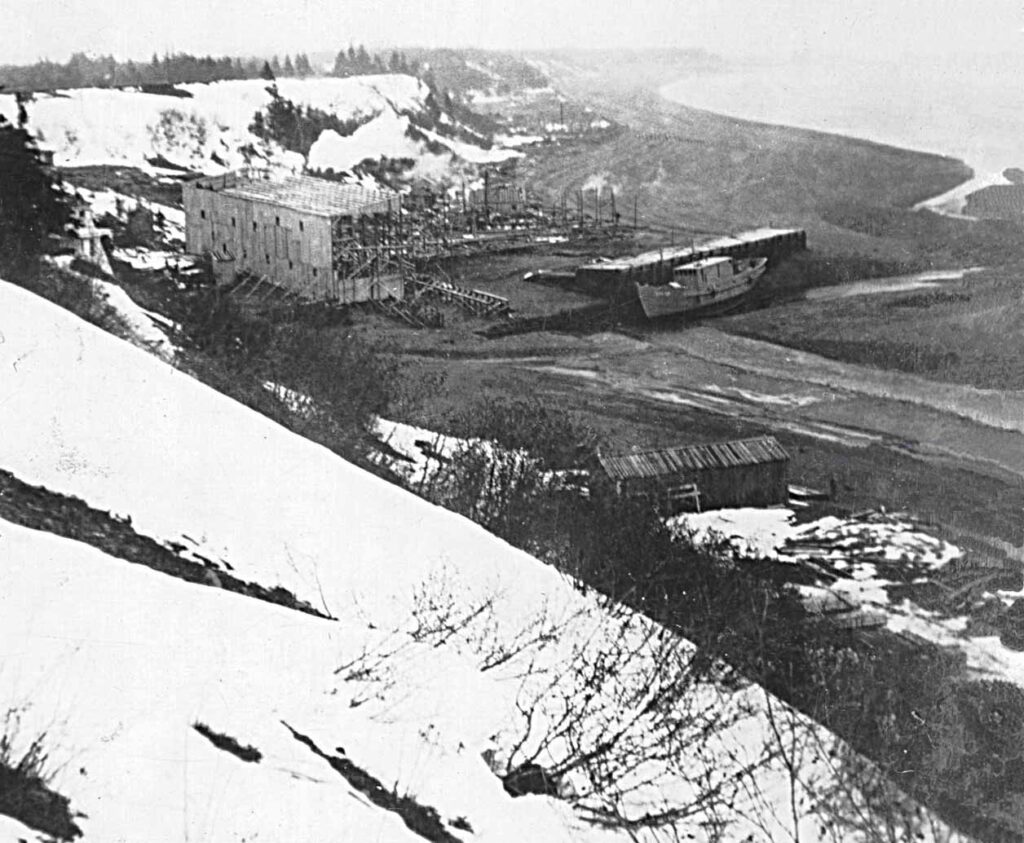
Wagstaff & Hatfield were by no means the only builders of MMS & Llewellyn Class Motorized Minesweepers, yards in the UK and abroad were tasked with production, in order to both increase the production rate and to minimize the damage the Germans could achieve across the fleets, should they target any particular type of vessel
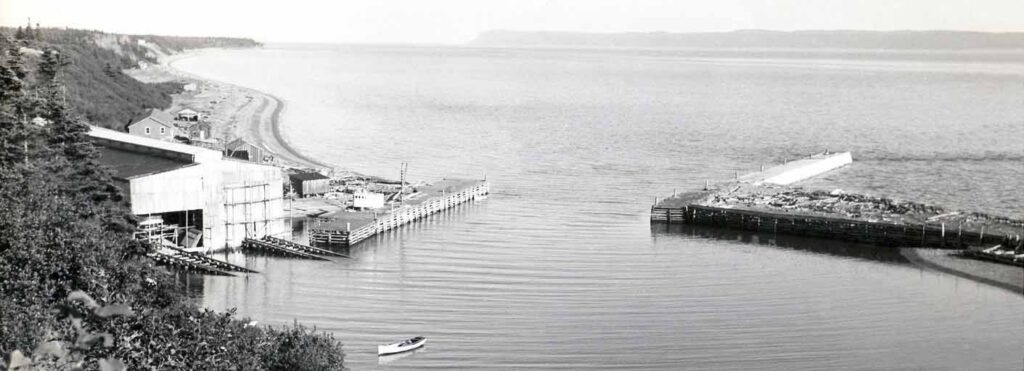
Those shipyards producing the 105 Ft MMS & Llewellyn (MMS specifically for the Royal Canadian Navy), according to the Reverend Michael J Melvin BEM (Melvin, M.J: “MINESWEEPER The Role of the Motor Minesweeper in World War II” Ch2, P23: Square One Publications, Saga House, Worcester 1992) included: “…19 yards in England and 11 in Scotland. By far the largest number of early 105 footers were built by Frank Curtiss of Looe, Par and Totnes.” Going on to add “In addition to the UK yards, orders were placed with twenty two builders overseas…a total of 91 vessels of the same type from Canada, Newfoundland, Rangoon, Beirut, Tel Aviv, Cochin, Kingstone Jamaica, Nassar, Hong Kong, Singapore and Colombo”
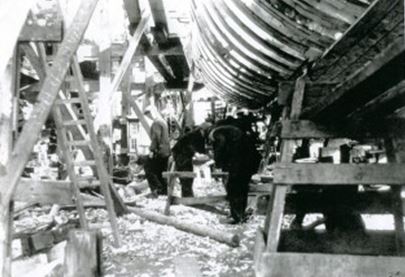
Port Greville became known for shipbuilding, more than eighty-four sailing vessels were built there, including seventy-six schooners, six Brigantines, one Barque, and one Barquentine. During WWII, Wagstaff & Hatfield, and their team of up to a hundred shipwrights and tradesmen, built wooden transfer scows. The company also took on a contract for 12 wooden hulled mine sweepers for the British Admiralty, which, due to the unpredictable freezing of the river Ratchford and the Fundy Bay area, were fitted out and finished in Shelburne before heading to the UK. The Port Greville Yard had been chosen for the Minesweepers as, according to the Government (Editorial “PROCUREMENT OF SHIPS-DEFENCE OF CANADA, 1939-41”, P46/7. Online Resource: http://www.cmp-cpm.forces.gc.ca/dhh-dhp/his/docs/Naval_Svc_vol2_e.pdf Accessed 20/12/2021) “British Columbia yards had had considerable experience with both heavy and light types of construction, and were equally capable of building M.L.’s and wooden minesweepers”
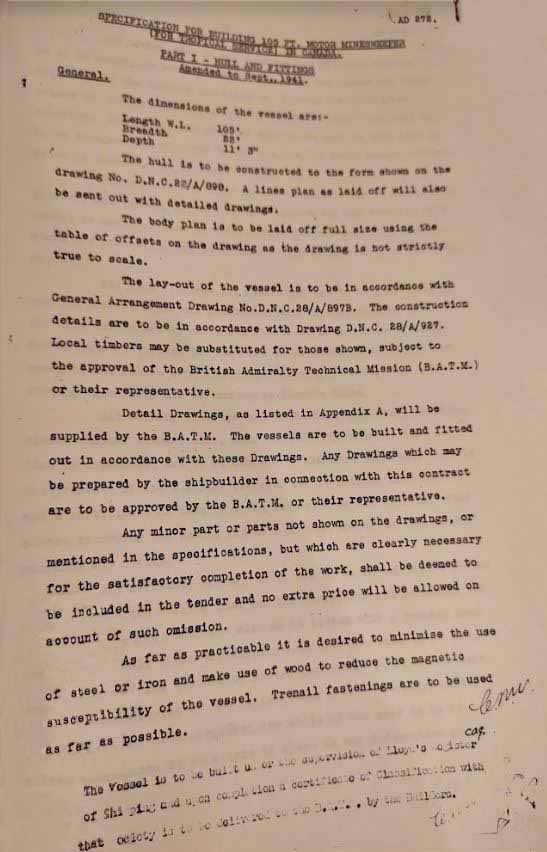
These craft were in addition to small fishing and pleasure craft usually built by the yard in times of peace. In 1957 the yard became incorporated as “Wagstaff and Hatfield limited”, Otto Hatfield left the firm but the yard continued building and repairing vessels until as late as 1972, only closing after a series of contracts were hit by inflation of costs caused by a financial crisis, and then quickly followed by a huge storm in 1976, which finally destroyed many of the main Wagstaff & Hatfield buildings
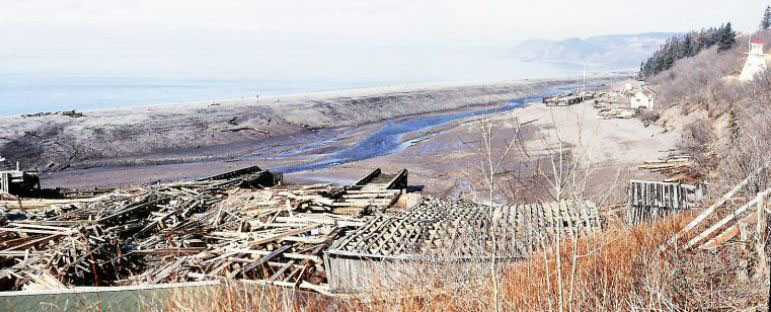
The Motorized Minesweeper & Llewellyn Class sweepers were small vessels at 105 Ft long and 23 feet wide………so, for those of you who, I know, are obsessed with detail:
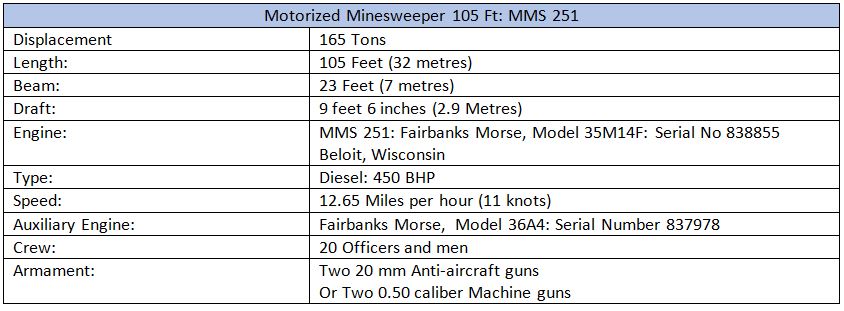
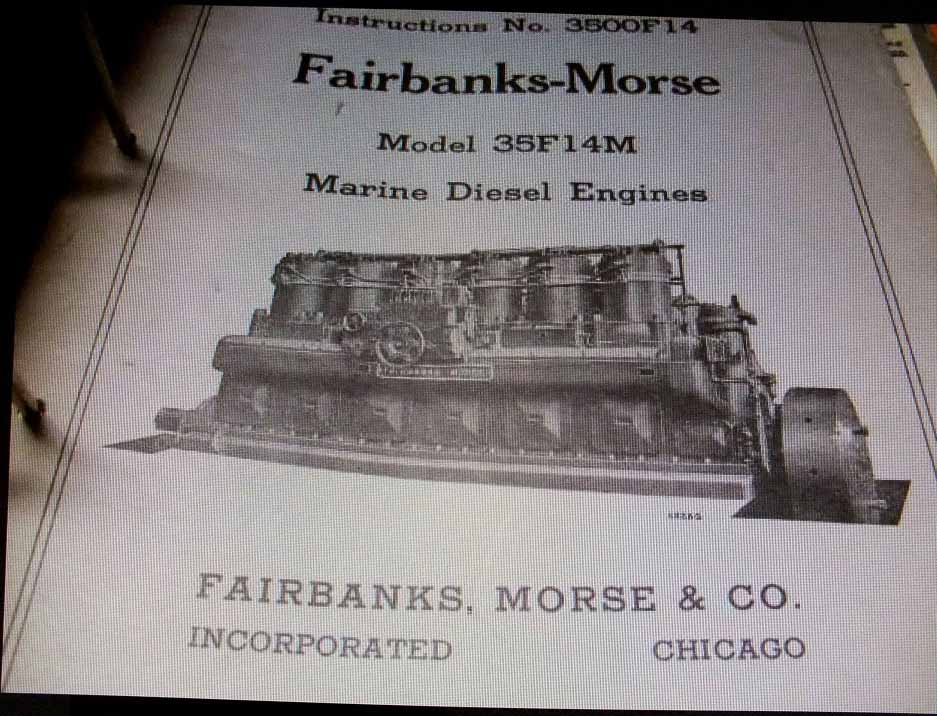
MMS251 was delivered to the Royal Navy on the 30th June 1943, joining the 143rd Flotilla at Swansea (Melvin, M.J: “MINESWEEPER The Role of the Motor Minesweeper in World War II” P51 and in Appendix F, P213: Square One Publications, Saga House, Worcester 1992), being assigned to T/LT Bernard Cakebread of the Royal Navy Volunteer Reserve in September of 1943. She was flying Pennant J751, and attached to minesweeping duties, using Longitudinal Line Sweep Gear (LL). The importance of minesweeping is so obvious it often goes unremarked, I see innumerable web-sites and articles about the war, but fewer about the importance of the vessels, and crews, risking their lives to ensure trade and materials get through dangerous estuary areas to dock safely. Every U-Boat commander and E or S-Boat Captain, and all the Nazi Bomber Command in the Luftwaffe, knew the importance of British Ports to the war effort, the German population had been brought to the brink of starvation by British blockading of German sea ports in WWI

It was vital to the Germans to block ports wherever they could, and to deny entry, or sink as many supply-ships as they could to weaken the spirit of the British public by attrition. It was also clear, after the entry of the US into the Second World War, that troops, planes, equipment and ammunition, were crossing the Atlantic in ever growing numbers. The cheapest and by far most effective way of denying access to British ports was the mine, Germany concentrated a huge effort to laying thousands of mines across the estuaries of the South Coastal ports of Plymouth, Falmouth, Bristol, and a determined campaign to do the same around the remainder of the country, Liverpool, Swansea, Sunderland and Newcastle Upon Tyne. It fell to the vessels of the Minesweeper Flotillas such as the Texas, Poulmic, Elk and MMS 251 to spot, snare and neutralize this pernicious threat
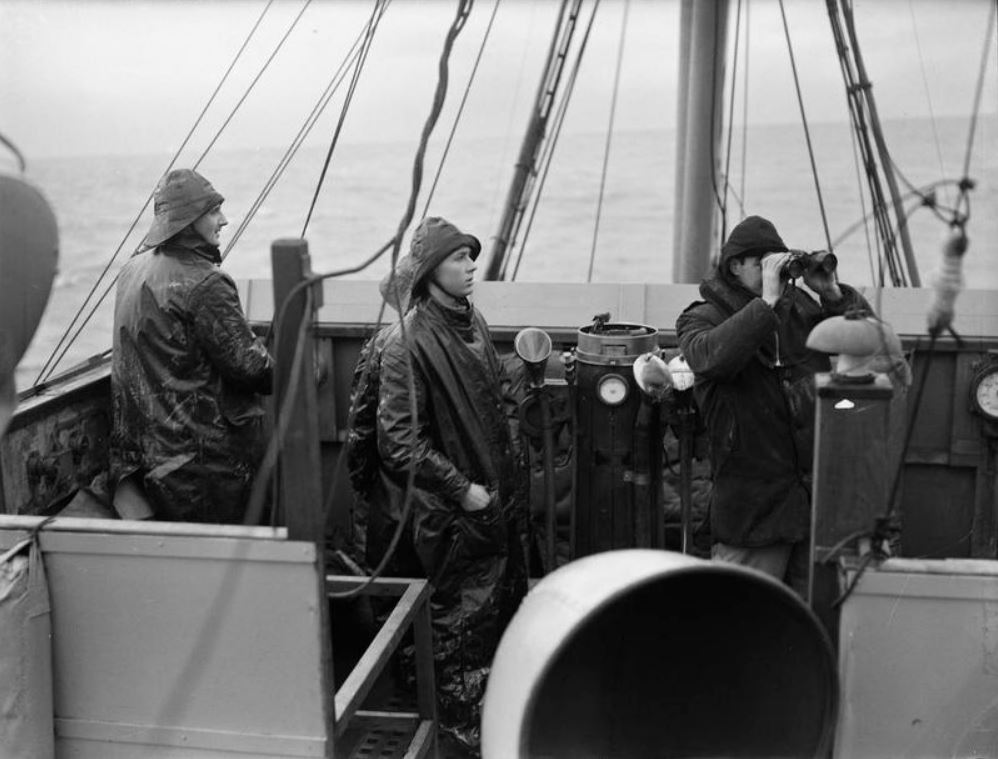
The MMS (& Llewellyn) Class of Motorised Mine Sweeper had Two main anti-mine countermeasures, the first being the Longitudinal Line deployment. This consisted of two heavy duty and highly insulated electrical wires trailed from the stern of the boat, hence the open transom at the rear of the vessels. The lines would have a pulse of electric charge sent down them mimicking the electrical signature of a large steel ship in order to detonate the magnetic, or “field sensitive” mines of the Germans
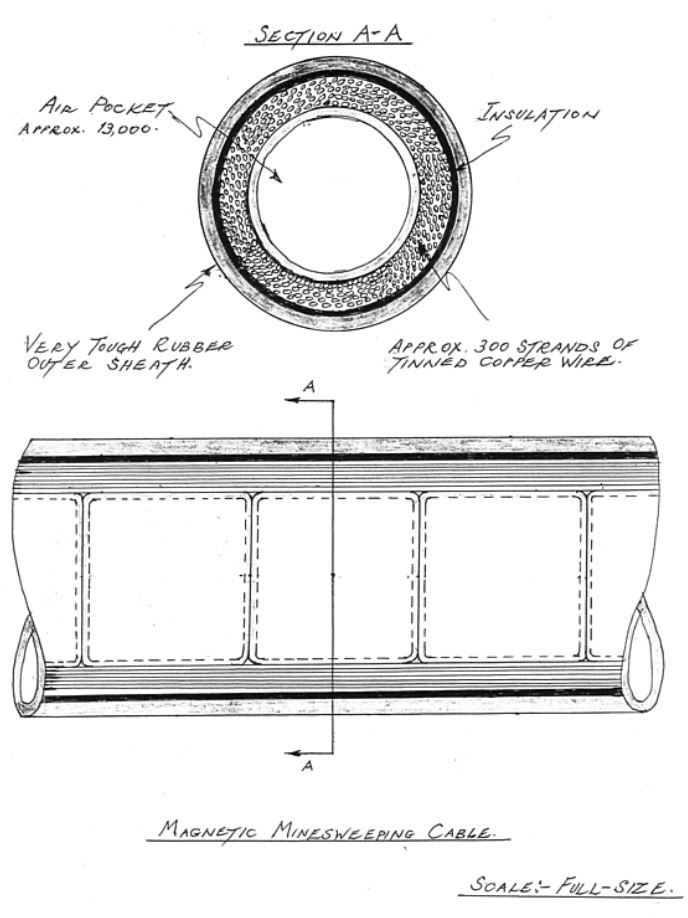
Usually pairs of MMS craft worked in a lane in parallel, each would deploy their lines and then one “Wire-man” would synchronize to the other’s sequence and they would run a sweep. Ernest A Goodall, the Leading Wire-man on MMS41 in World War II, describes the procedure (Goodall E. A. in “Wartime Minesweeping Memories, Sweeping Procedure” Para 2. Online Resource: https:// www.mcdoa.org.uk/ Wartime%20Minesweeping%20Memories. htm Accessed: 22/12/2021):
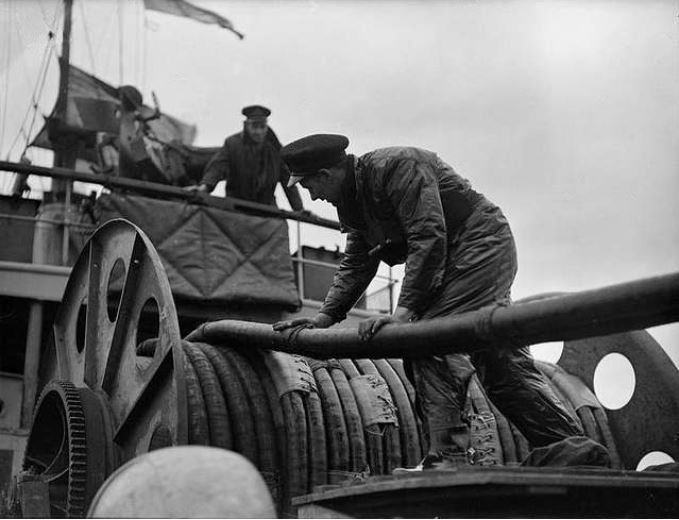
“I would signal the partner to switch on and start pulsing. Their pulse indication lights would come on for five seconds in every 30 seconds; one light at the forward location meant that they were putting a positive feed out through the short leg which produced a north magnetic field between the ships. Their next pulse would show me two lights; one at the forward location and one aft, indicating a change of polarity. Now I had to watch very carefully for when their single light came on, i.e. forward location, and when it went off. When it went off I would immediately switch on the Venner time clock again. Then both ships should have been synchronized but sometimes I may have been a bit slow on switching on again and perhaps lost a second. If this happened, I had to get through the operation again until I got it spot on”
Later in the war the Germans developed multi-polarity mines, which meant the MMS flotilla’s needed to run two sweeps of each channel to ensure both North and South polarity sequences had been covered
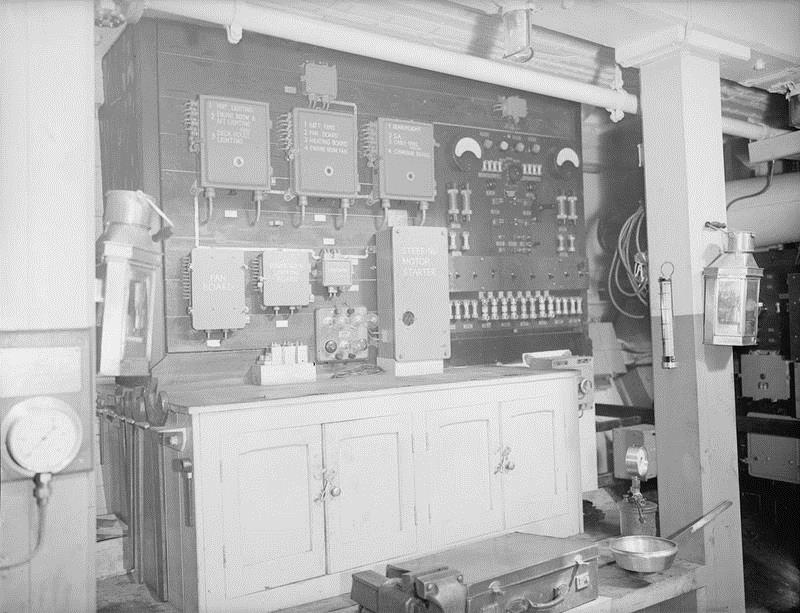
The second mine countermeasure the MMS flotillas were often fitted with is the Kango, or Acoustic Hammer, a device developed, as it seems clear, from the Kango hammer drill. The rotating percussion element of the hammer was fitted, originally, in a forward compartment in ships and operated from within, but it quickly became apparent that it left the ship in clear danger of being on top of an acoustic mine when it detonated, it may be that is what took the HMT Elk (another wreck dive featured on this site) to the bottom of Plymouth Sound
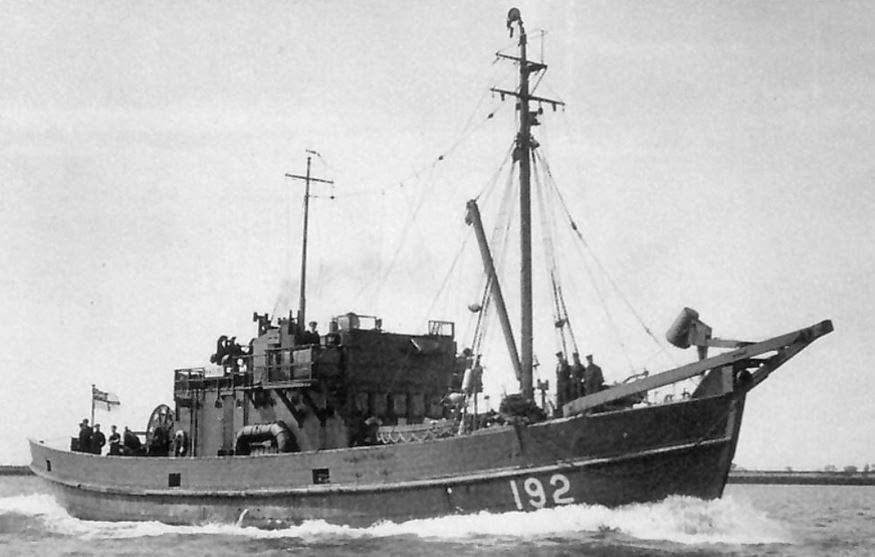
The answer came from scientific advances, most likely from the Royal Naval Engineering College (who were using the Elk for experimental steam powered devices), who placed the Kango into a waterproof Cone (probably amplifying its resonance at the same time as protecting those on the vessel using the device), and mounted it at the front of the MMS on a boom arrangement, or dropped it over the side on a wire, via a winch, using a device similar to a trawl or lifeboat Davit, there’s an excellent photo of that operation, from as late as the Korean War, again in the piece on HMT Elk elsewhere in this blog

The MMS, affectionately nicknamed “Mickey Mouse”, after the popular Disney Character, were small craft in the scheme of things at 30m or so long, they carried a crew of around 20, from the Captain, (often denoted T/Skipper, or “Trawler Skipper”, a Royal Naval Reserve (RNR) or Royal Naval Volunteer Reserve (RNVR) rank specific to the minesweeping flotillas), then First Officer, usually a Lieutenant, the Coxswain, a Signalman, an Engineer, a Wire-man (often also the signalman), a Leading Seaman, and, if they were lucky boats, a Cook, and then to the “Ordinary Seamen” and AB’s (Able-Bodies) numbering between 10 and 12 per boat. That is a considerable crew considering the size of the boats and the accommodation aboard
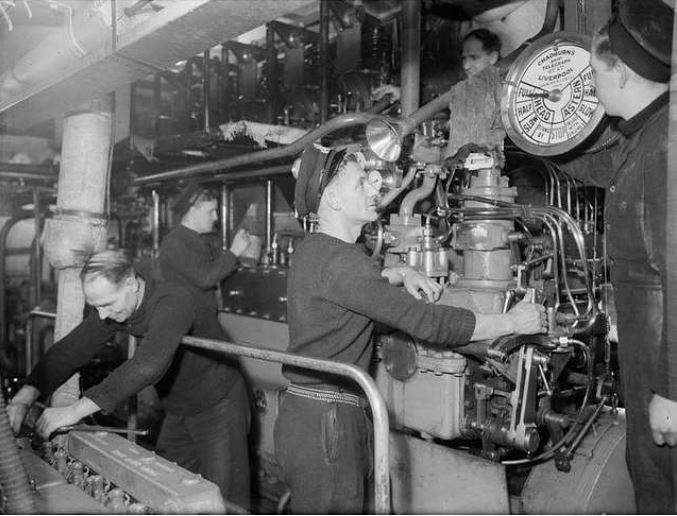
Key to the operation of the sweeps, was the Radio Operator, a position my step-father was assigned to on another small vessel type in World War II, the Motor Torpedo Boat, or MTB. Another small craft, but one designed for speed to counter the E-Boat threat and to enable fast reaction to downed air-men in the Channel, Another perilous activity, in what Vic described as, “continual sea-sickness and horribly cramped conditions”, no wonder he volunteered for Commando Training as soon as he was allowed!
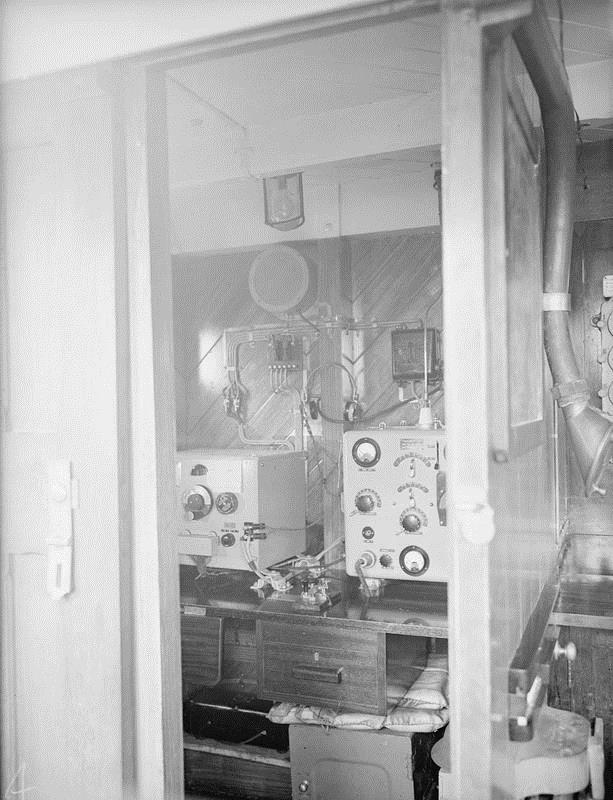
Nevertheless, it was the Radio Operator who coordinated the wire-sweep polarity’s, and was often the wire-man, responsible for the frequency and pulse of the longitudinal sweep too. Another wire-man, Reg Breary, from Liversedge in Yorkshire assigned to MMS 256, recalls (Breary, R. in “ROYAL NAVAL PATROL SERVICE – REG BREAREY” Online Resource: http://www.hmsgangestoterror.org/rn-patrol-service.html Accessed 27/12/2021) “….there were two huge Cummins diesels with English Electric 47 kw. generators which would put out a magnetic field of 5000 amps for a few seconds pulse both North & South (one at a time of course.) There were 48 submarine batteries to take part load on pulse”. The difficulty of that task should not be underestimated, considering the dangers of getting the synchronization out of phase with the opposite number MMS, when carrying out the lane sweep (as Ernest Goodall describes earlier in this piece), everything depended on the function and settings of the electrical wire signals, or everyone aboard was at extreme and mortal risk

It did not take long for MMS251 to be in the thick of things, in Swansea that would mean clearing the approaches to the docks, keeping the U-Boats and Heinkel’s from any chance of success laying minefields from the sea or from the air, it would be unlikely E-Boats would operate anywhere near that far up the West Coast, but there would always be the chance a German Minelayer might get near enough if the 143rd Flotilla guard dropped….. There were hushed plans underway behind the scenes at the Admiralty, MMS251 and her sister ships would play the biggest part in their chances of success at a very early stage of the execution of those plans. Operational orders were underway for the invasion of Normandy, the re-taking of France and the lowlands and, eventually, the defeat of Adolf Hitler’s Third Reich:

ONEAST 6.–Instructions for Minesweeping
10.4.44
INFORMATION
Minesweeping Forces
1. The following is the allocation of the minesweeping forces available. (For details of
the composition of flotillas and groups see ON6, Appendix III.)
Eastern Task Force Task Force Commanders (Eastern: Rear Adm. Sir Philip Vian RN;
115th M.S.F. (M.M.S.) .. .. .. .. .. Force S.
143rd M.S.F. (M.M.S.) .. .. .. .. .. Force S.
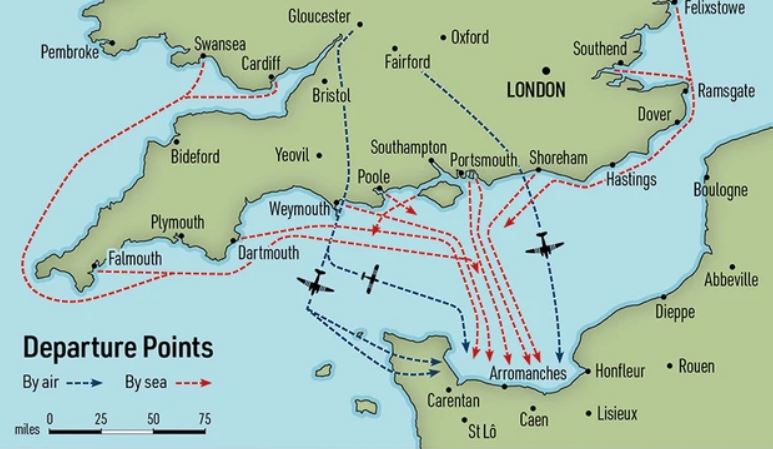
By the time these plans were confirmed and the forces required had been determined MMS251 had a new Captain, “On 23 Jan 1944, C. G. C. COOMBE took Command of MMS 251 (short-boat Motor Mine Sweeper otherwise known as a ‘Mickey Mouse’) as an Acting Temporary Skipper RNR with a seniority of 9 Jan 1940 and then as an Acting Lt Skipper RNR with a seniority of 9 Jan 1940. He remained in Command until at least July 1945” (Naval_Gazer. Posted in Blog Thread https://www.navy-net.co.uk/community/threads/the-first-floatia-of-minesweepers-on-d-day-6th-june-1944.74808/ Online Resource: Accessed 27/12/2021)
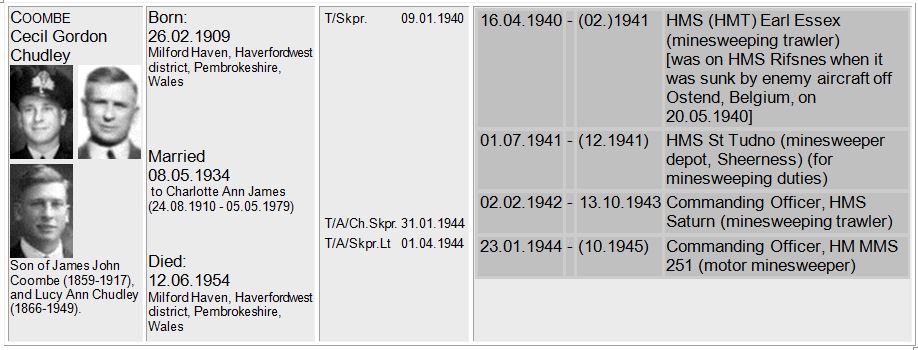
The minesweepers of 143 Flotilla, and their colleagues from Operation Neptune, sailed in advance of the task force on the 03rd June of 1944 to clear sea lanes needed to get the assault and landing forces across the English Channel, Wire-man Reg Breary, again, recalls: “…So June 3rd about 50 M.M.S. set sail after dark, we could only guess where we were headed but no generators required for 3 hrs. so a good time to top up the batteries, no codes were given to me at this time so we were sure it had to be France.” (Breary, R. in “ROYAL NAVAL PATROL SERVICE – REG BREAREY” Online Resource: http://www.hmsgangestoterror.org/rn-patrol-service.html Accessed 27/12/2021). The undertaking was enormous, the logistics involved had taken over a year of planning and were complex, depending on the collaboration of multiple allied forces, British, American, Australian, New Zealanders, Polish, Dutch, French, Canadian……. and many other colonial forces brought together for one purpose, to defeat the Germans and re-take Europe
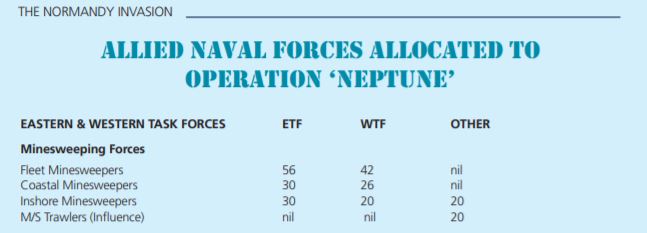
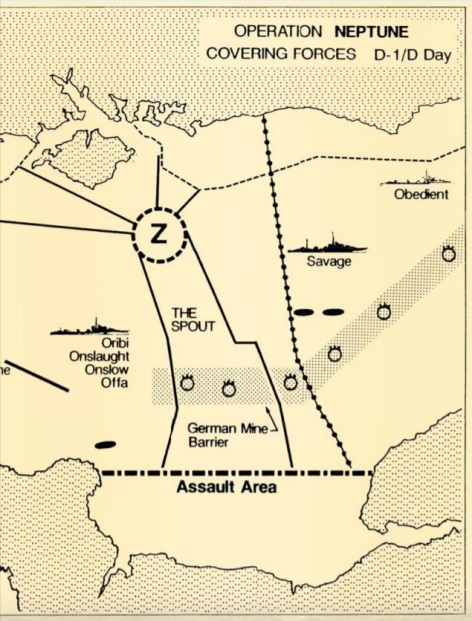
The work involved to clear such an area of sea both offshore and (later that night through to early morning), the near shore areas of the Normandy beaches, can only be described as daunting. David Verghese describes the planning in his piece on the Royal Navy Minewarfare & Clearance Diving Officers Association web-site: (Verghese, D. “Operation Neptune: the Minesweeping Operation 5-6 June 1944” Online Resource: https:// www.mcdoa.org.uk/ Operation_Neptune_Minesweeping.htm Accessed 30/12/2021) “In respect of each of the five beach Assault Forces (designated U, O, G, J and S), two channels would be cleared S.SE. through the mine barrier for the first wave of amphibious infantry on what would be termed D-Day. One assault channel would be for 12 knot convoys and one for slower 5 knot convoys. These channels were to be numbered 1-10 from west to east”. The ramifications of missed mines would be catastrophic to the operation, the dangers implicit in clearing the sea routes were perilous, not only the act of capturing and neutralizing the hundreds of mines, but the threat of air and sea attack from an enemy determined to prevent the assault
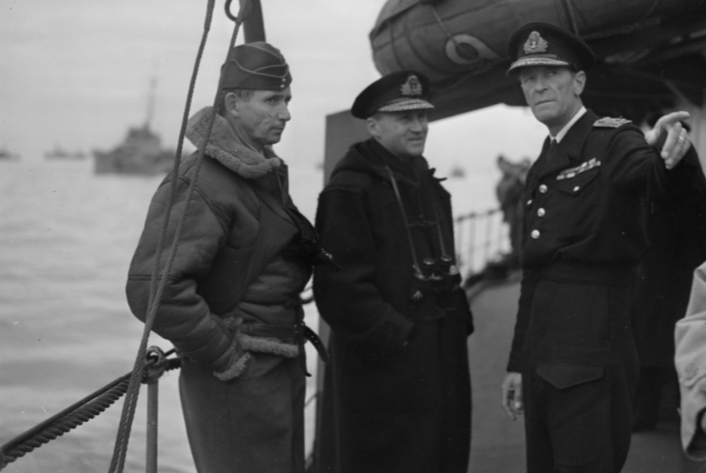

Verghese goes on to note the importance of the advanced planning undertaken by Admiral Bertram Ramsey and his Task Force Commanders (Eastern: Rear Adm. Sir Philip Vian RN; Western: Rear Adm. Alan G. Kirk USN): “A Fleet Minesweeping Flotilla (MSF) of nine ships would be allocated to each channel to sweep well ahead of the invasion vessels. It was of paramount importance to conceal from the enemy the time and place, and indeed intent, of the landings by the forces following up behind”. It is a testament to the secrecy of the planning, and covert assembly of the assault and landing fleets, the deception employed by the allies (to misdirect the enemy and have him expect an attack in an entirely different location than that intended), and the flawless execution of the plan, that ensured the success of Operation Neptune. If it had not been for the Minesweepers and Dan Layers of the Eastern & Western Task Forces, it might have looked completely different from that which confronted the German Army on Omaha, Gold, Juno, Sword and Utah beaches on the morning of the 06th June 1944
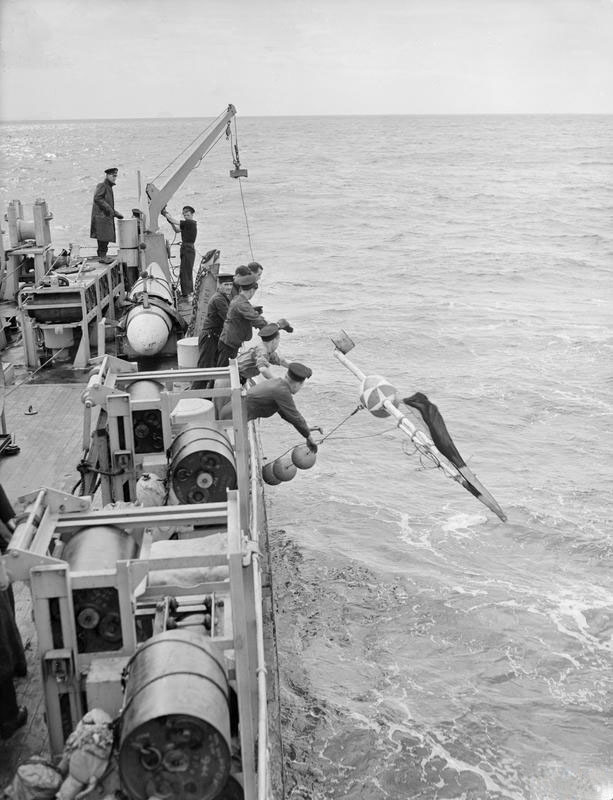
The work of the D Day clearances lasted far longer than you might imagine, the German Kriegsmarine and Luftwaffe did not simply abandon the seas and skies over the Normandy beaches, and constant re-mining was attempted over the days of June, July and August by sea using E Boats, and U-Boats and by air using Heinkel’s. As the land based attack became more successful and the beachhead was secured, the assaults moved inland and a fast expansion into France necessitated more supplies
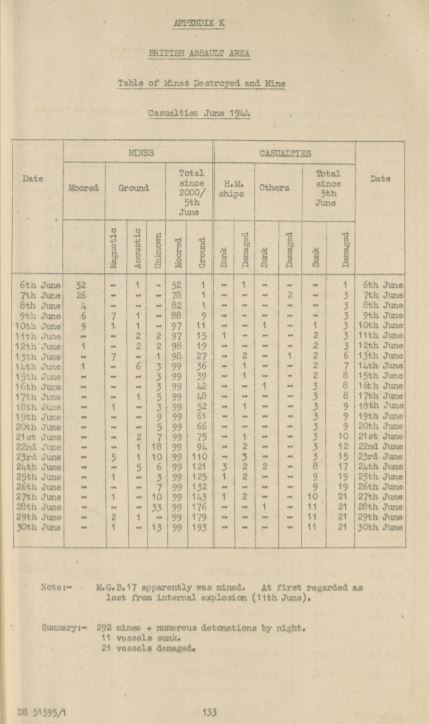
MMS251 played an integral part in the clearing of mines during Operation Neptune, one of her Officers (likely 2nd in command/First Officer), Lt G W Lambert (RNVR), being mentioned in despatches. The success of Operation Neptune minesweeping was not absolute, one of the troopships carrying American soldiers of the 90th Infantry Division did suffer damage from mines. The Susan B Anthony hit two mines whilst travelling off Utah Beach, despite the severity of the two explosions, in an exemplary operation in the circumstances all troops were safely evacuated from her, without loss of life, on the 07th June of 1944. The work of mine clearance, carried out under accurate and consistent fire from land, sea and air by the German forces did not go un-noticed, Rear Admiral Alan Kirk USN: “It can be said without fear of contradiction that minesweeping was the keystone in the arch of this operation. All of the waters were suitable for mining, and plans of unprecedented complexity were required. The performance of the minesweepers can only be described as magnificent”……, however Normandy would not be the last mortal danger MMS251 would place herself and her crew in!
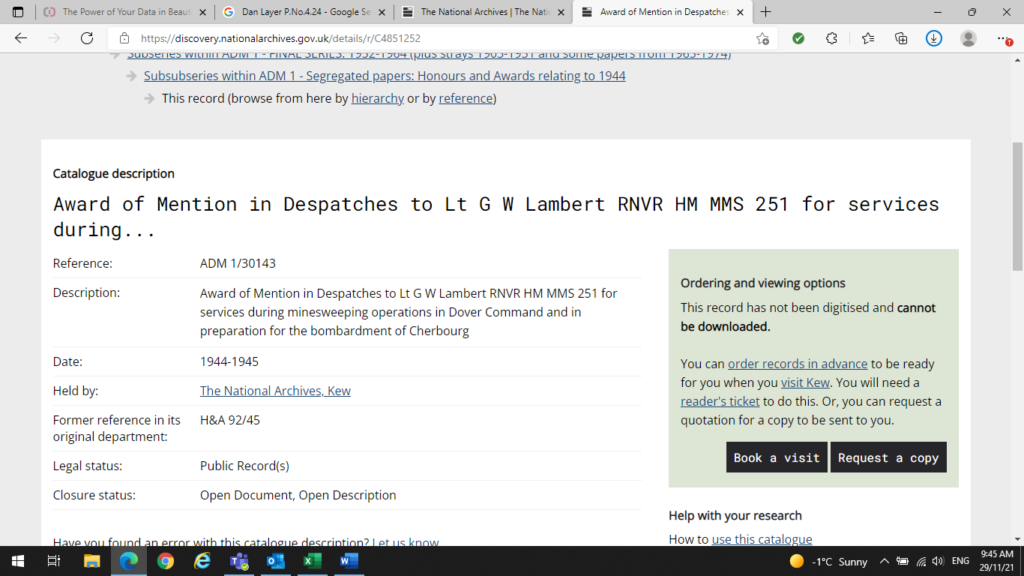
Sadly the war was far from over, the Nijmegen parachute drops 17th September of 1944 (Operation Market Garden) intended to secure the bridges over the Rhine River at Arnhem (for the crossing of units passing through the beachhead moving through France on into Belgium & Germany), had isolated troops a step too far from the advancing forces and, after a bloody and determined battle, they were in danger of losing the initiative through lack of supplies. The next battle phase was to be securing the approaches to Antwerp, to take the port as a re-supply route to the North-West flank of the invasion. It would, again, fall to the minesweepers of the allies, to clear the routes for the Navy bombardments and landing of men and supplies to underpin that effort
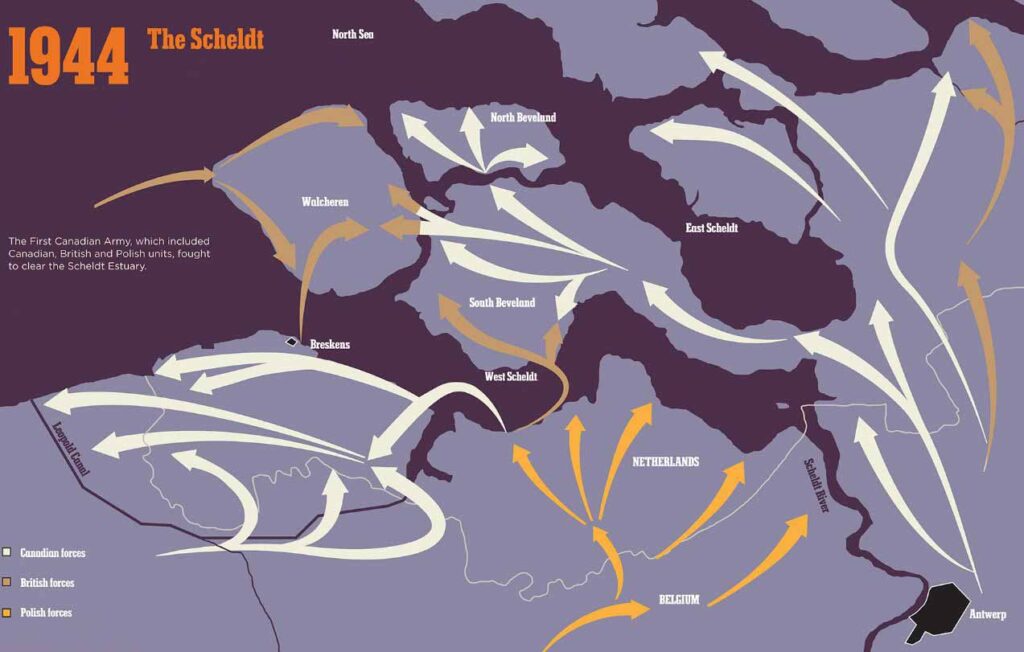
The Second British Army managed to take Antwerp but the Scheldt River approach was still held by the German Army, without taking the river there was no access from the North Sea to Antwerp. Dwight Eisenhower, the supreme commander of the allied forces Europe, made it clear to Winston Churchill in a telegram (Editorial “Sweeping the Scheldt” Online Resource: http://www.wildfire3.com/sweeping-the-scheldt.html Accessed 28/12/2021) “Unless we have Antwerp producing (unloading ships) by the middle of November our entire operations will come to a standstill. I must emphasise that, of all our operations on the entire front from Switzerland to the channel, I consider Antwerp of first importance.” The German soldiers the Canadian 1st Army & British 2nd Army would face were the 15th German Army, Army Group B and Army Group H, supported by battle hardened paratroopers, taking the banks of the Scheldt and carrying out minesweeping along the estuary and the river would be nothing short of brutal

There is no definitive proof MMS251 was at the Scheldt for Operation Calendar in November of 1944, nor her sistership MMS250 (MSF 142, Plymouth), however, as we can determine MMS251 was assigned to the 143rd Flotilla (Swansea), there is anecdotal evidence she would have been there: Michael Melvin records the loss of two of the 143rd Flotilla’s Minesweepers 248 & 257 (Melvin, M.J: “MINESWEEPER The Role of the Motor Minesweeper in World War II” Chapter 8, P121: Square One Publications, Saga House, Worcester 1992) which are noted as “Sunk River Schelde”. It is apparent Mine Sweeper Flotilla 143 (MSF 143) was deployed in support of operations to clear the Schelde, which means it is also a reasonable assumption to conclude that would include MMS251. As is often sadly the case in the smaller vessels of the war, there were high casualty rates, and the loss of lives in respect to smaller ships was proportionately far less than for the loss of larger naval vessels, often meaning the reporting of loss of smaller craft was not as accurately investigated or recorded
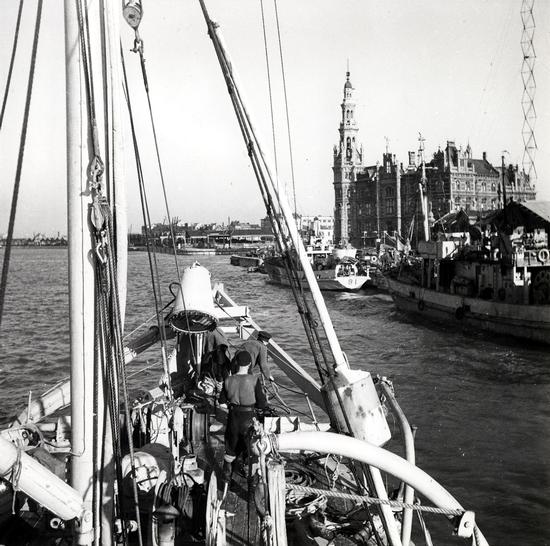
I have not intended to look at the battles fought along the River Schelde in detail, that is for those who are tracking the land and air assaults, and who would do far better justice to such complex and asymmetric warfare. I will, however, mention the ferocity of the German defence along its length, and the huge effort to re-take Antwerp in the famous Battle of the Bulge, where the German Army pushed back desperately, until a combination of fierce retaliation by the Allies and the limits of fuel for the German Panzers & Tiger tanks and personnel transporters was reached, for, if it were not for the Minesweepers clearing the Schelde, allowing supply-ships into Antwerp, there would not have been re-supply of vital ammunition, fuel, food and men to defend Antwerp and turn the tide of the desperate German advance
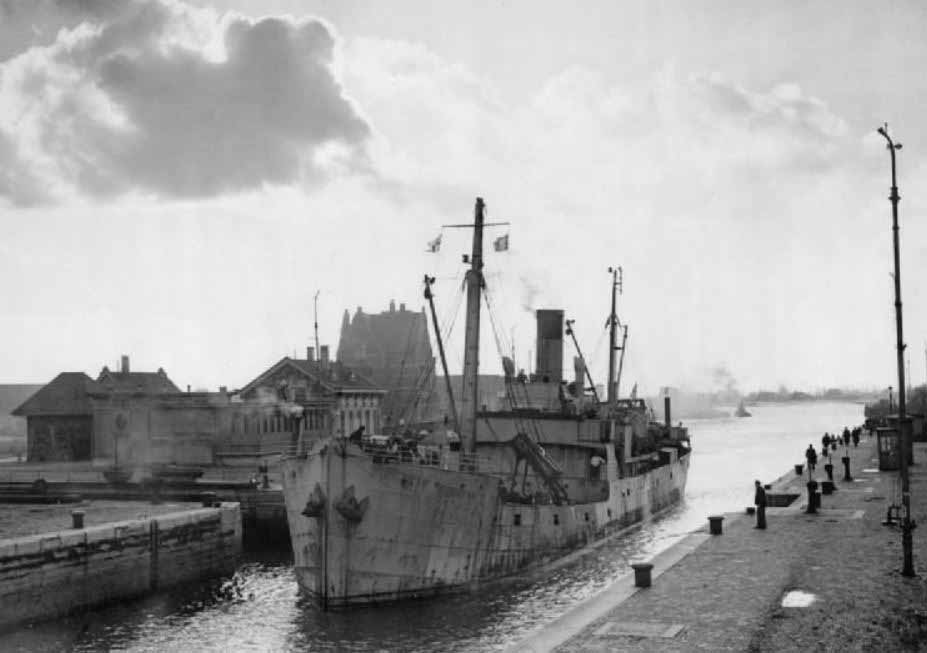
The Schelde secured, the Battle of the Bulge won, by January of 1945 the writing was on the wall for Hitler and the Reich, it did not take long to have the German Army in full retreat back to Berlin and, 08th May of 1945 saw the unconditional surrender of all German forces and the declaration of Victory in Europe…….That would not be the end of the war for the minesweepers of the Allies, the seas of the world would never truly be free of mines, a world war two parachute mine came ashore in England (Bognor Regis) as late as 2018, and undoubtedly they will continue to do so, but determined efforts were made by combined fleets of Minesweepers until the late 1940’s when the operations were scaled down and eventually ended. The Minesweepers now redundant, the War Office began disposals of those deemed fit for sale and, in 1949 both MMS250 and MMS251 were bought by a Norwegian and a Falkland Island concern and here the fate of both became a little murky………

The notification of Sale from “Arsenal of Democracy North: Canadian Naval Shipbuilding of the Second World War” (P99), a work on shipbuilding undertaken by the Canadians on behalf of the Allies during the war, clearly indicates MMS 250 available but MMS251 having been sold to “Commercial Harstad” in 1947. I have no idea where David Shirlaw’s information came from, and I notice the sale date as being 1947, but further investigation indicated an anomaly with this information as Robert Rowlands, whose father was the Engineer on Protector III, was convinced she was MMS251, and backed that up with information from a Norwegian site (MMS250 http://www.skipet.no/skip/krigsbygd/motor-mine-sweeper-mms-110-fots-klasse/mms-250) showing the Harstad (formerly, according to the site, MMS250) “MMS 250 ble bygget om til lokalruteskip HARSTAD og utrangert i 1966” which translates as “MMS250 was converted to a local cruise ship HARSTAD and scrapped in 1966”
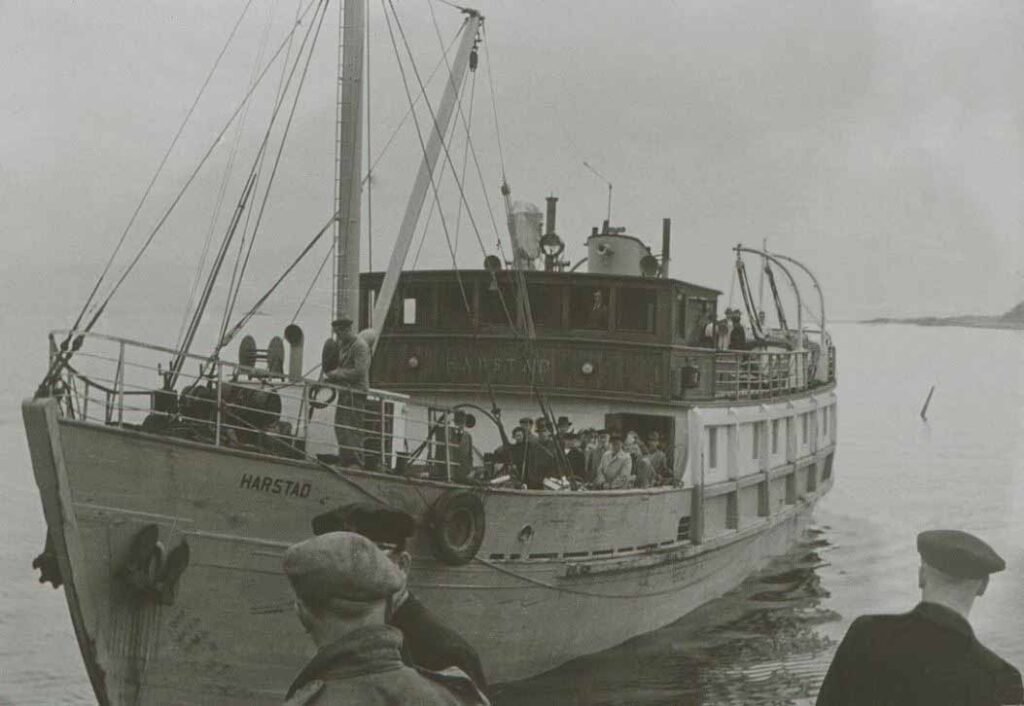
So we start the investigation with anomalous and conflicting information, is the Protector III, sat on New Island in the Falklands, MMS250 or 251, and to whom and when was she sold, 1947? I suppose for most it would not matter, if the Protector III is “either” does it really make a difference? I am not sure if it is just me or if there are others like me, (I am sure there are…. poor sods) that would far prefer to know precisely “which is which”….. whatever the case, if you are interested in history, especially the history of ships (as there are often many built to the same plans), it just feels better knowing you have the “right” name matching the right numbers (ask any classic car aficionado….they are somewhat manic about “matching numbers”….). Robert Rowlands had a little more information in the form of the main and auxiliary engine serial numbers: “Protector III official number 166895 registered Kings Lynn 22.09.1947, Main Engine: Fairbanks Morse Model 35M14F Serial No 838855, Auxiliary Engine: Fairbanks Morse, model 36A4 Serial Number 837978” which he sent to me when I shared the detail I had found in David Shirlaw’s work. But Robert wasn’t on New Island to physically confirm the numbers on the wreck, and wasn’t going to be until January 2022 so there was time to dig a little further……
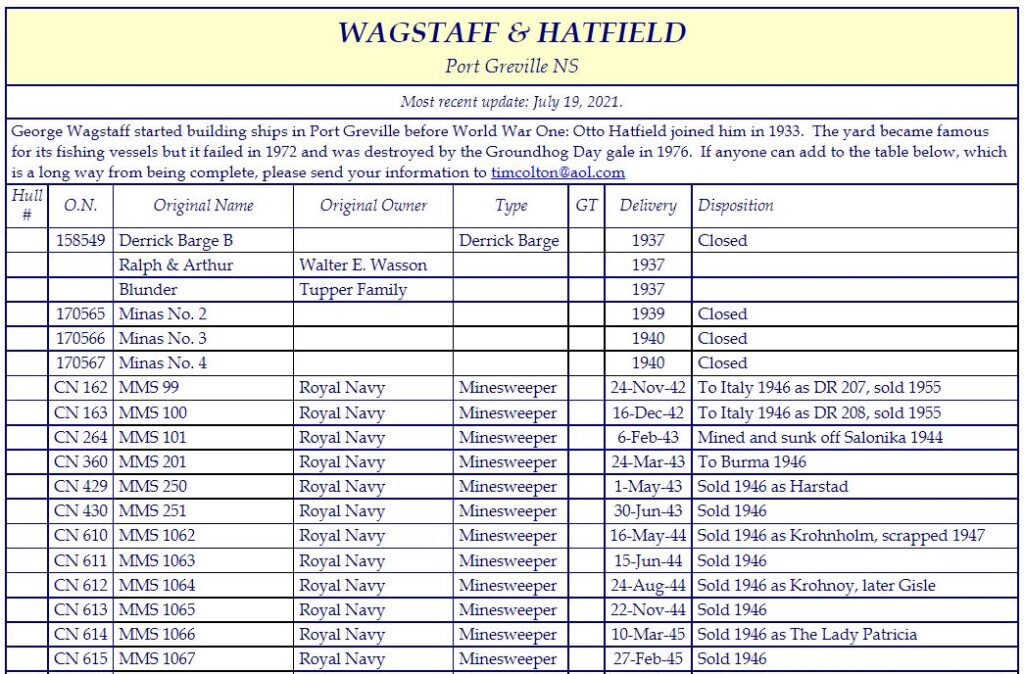
1st port of call, the registration documents for Kings Lynn in 1945 or after……nothing, not a jot! Next I looked at the Wagstaff & Hatfield Records, it turns out these were available online through shipbuildinghistory.com, sadly there was not sufficient detail to confirm anything more than the delivery and sale dates, both were supposedly sold in 1946 and in the Hatfield records indicate it was MMS250 sold as Harstad, which gave us two sources identifying MMS250 as the vessel sold into Norway. So the search continued and it turns out it is by no means an easy thing to find detail on these small vessels, it is as if history has simply forgotten them. I sought help from the museums in Canada, and although they were all very helpful, there was nothing more than I already had, and nothing specific enough to identify definitively that MMS251 was Protector III, even though I was becoming as convinced as Robert was that it was MMS251 on the New Island beach…….Perhaps the Falkland Islands had the answer? I had been helped with research on the John R Kelly (another shipwreck written up elsewhere on this site) by the Falkland Islands Museum and the Jane Cameron Archive in Port Stanley, these are two separate entities, as I found out inadvertently when I copied both in a single e-mail and was politely scolded for so doing, lessons learned, and happily my faux pas had not mortally offended it seemed. I was sent some amazing copies of the documents held in the Jane Cameron National Archives:

I now had the Captain who delivered the Protector III into Port Stanley 14/11/1949, a Mr A. Monk, things were getting interesting! I was very grateful, (by some co-incidence, which my wife Ellie seems to have been somehow involved in….) to receive the Michael J Melvin Book “Minesweeper, the role of the motor minesweeper in world war II” from my youngest son Kai this Christmas and, besides making very interesting reading on the operations and flotillas, it also asserts MMS251 became Protector III, and confirms the sailing to the Falkland Islands under Captain Monk: “….the hulk turned out to be ex-MMS 251 also built in Canada, but which served in the U.K. Her story is that following her war service, she became a Fisheries Protection Vessel and was named Protector III, but was sold to the South Atlantic Sealing Company. A Mr. A.B.Monk, OBE, from whom the story comes and who held a deep sea certificate, was invited to sail Protector III to the Falkland Islands, with another vessel, the Golden Chance in tow. With the help of 120 fathoms of 9” coir rope, a successful 5,500 miles was completed. Actual steaming time was 42 days, starting at Colchester, Essex and visiting Lisbon, Las Palmas, St Vincent, Pernabuco, Rio, Montevideo and Stanley. That was in November of 1949” (Melvin, M.J: “MINESWEEPER The Role of the Motor Minesweeper in World War II” Ch5, P80: Square One Publications, Saga House, Worcester 1992). All the documented detail still lacks the vital information I am after, in respect to absolute proof Protector III is MMS251
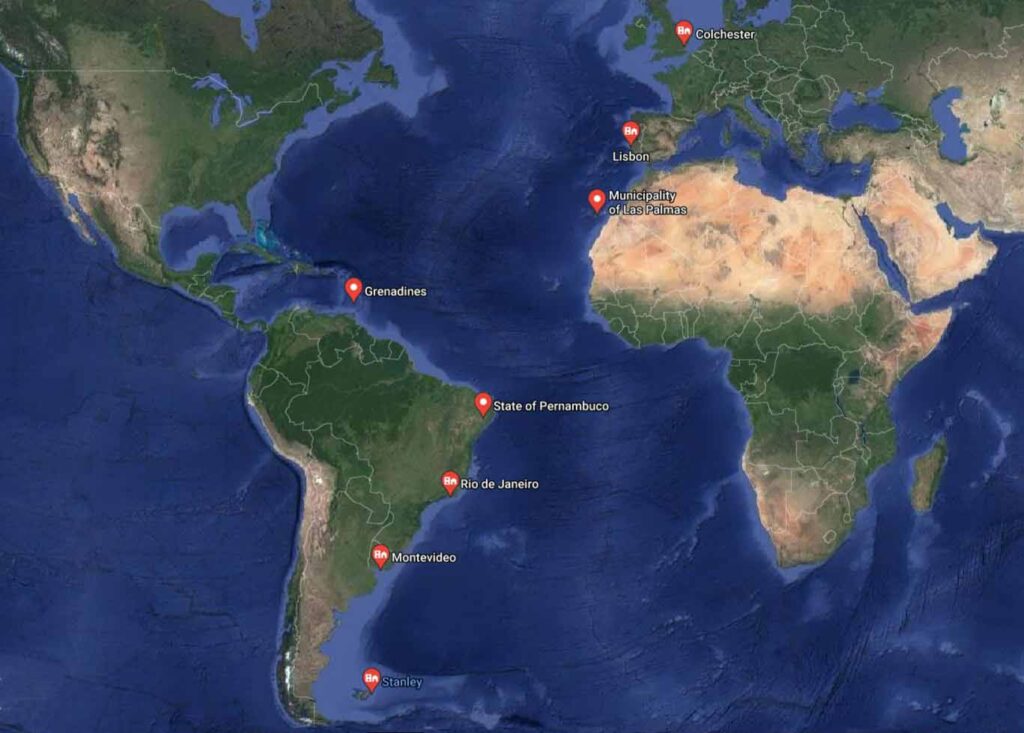
Looking at the journey completed by Captain Monk it is, to say the least, a daunting undertaking. The idea of a 5500 mile North and South Atlantic sea voyage is not new, whalers completed such journeys in the days of sail and on into the age of steam, however Captain Monk had another layer of complication in regards to the towing of the Golden Chance, herself a similar size to the Protector III. The Golden Chance had been a 90 Ton, 84ft Lowestoft Steam Trawler (LT371), built by John Chambers Ltd and fitted with a Crabtree & Co (Lowestoft) Steam Engine, (LT371 “Lowestoft Registered Boats”. Online Resource: https:// sites.google.com/ site/ukboatsgycouk/ lowestoft-registered-boats-3/lowestoft-registered-boats Accessed: 28/02/2022) she would be a secondary supply ship for the South Atlantic Sealing Co and was purchased, along with Protector III, by the Colonial Development Corporation for work at Albermarle
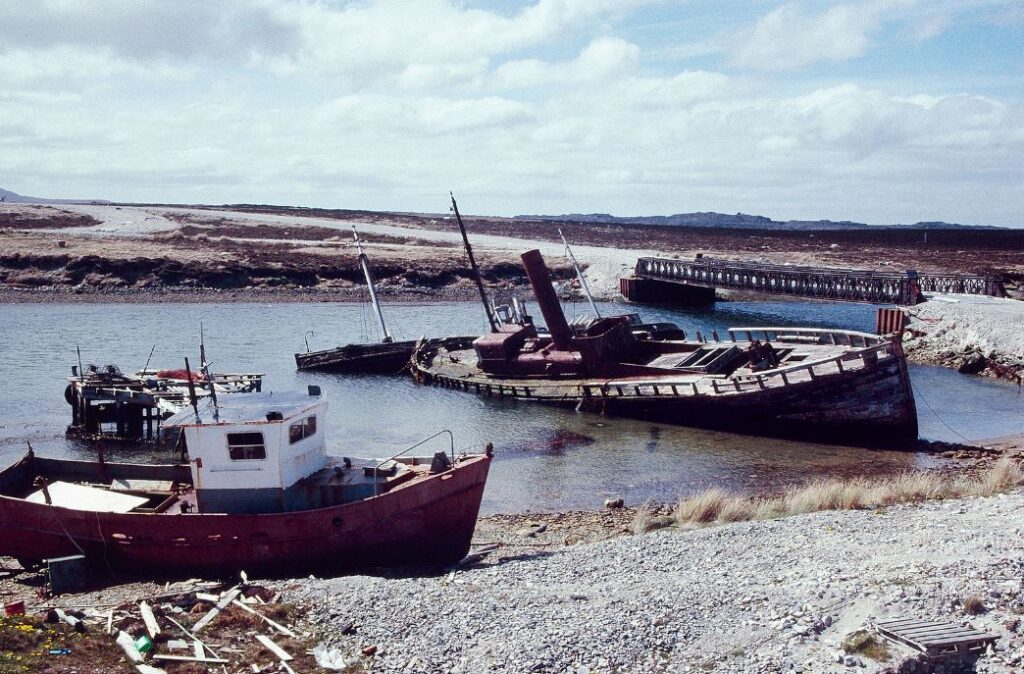
None of the information given during the recounting of Captain Monk’s epic voyage furthered the identification of Protector III, but it is all fascinating and leads the reader on a journey across over 5500 miles of Ocean (in and of itself deserving of a book at least) and through the 5 or so years of her working life in and around Port Stanley, the Capital of the Falkland Islands, and a little later on it all helped me identify an obscure piece which described the reason for her beaching on New Island

It would seem this also identifies the 1949 port of embarkation in the lead photo for this piece as Colchester, (specifically Wyvenhoe) but, again, there is nothing “concrete” in the piece identifying which MMS this was, no bill of sale, no transfer of ownership papers, or register of re-naming, just word of mouth from Captain Monk and this time the purchaser is identified as “The South Atlantic Sealing Company”…….. The purchasers of MMS251 (from the Fisheries Protection Department), seemed up to that point to have been the Colonial Development Corporation, a Government enterprise set up to help the economic development of British Colonial interests which, of course, included the Falkland Islands. Why was a war surplus craft, especially a small, ex-coastal minesweeper at that, crossing an Ocean and undertaking a 5500 mile journey to the Falkland Islands? I hoped to find out more from the references to both the Colonial Development Corporation and the South Atlantic Sealing Company, so I started to look into sealing activities in the 1900’s but that turned out to be a more difficult task than expected…… I found an article by Ian Strange (the New Island owner when I was diving the Falklands in 1996), which briefly mentions a 1949 sealing operation in his publication (Ian Strange “Sealion Survey in the Falklands” P177, Para 3. Online Resource: https:// www.cambridge.org/ core/journals/oryx/article/ sealion-survey-in-the-falklands/ 7B6CDEA9DE036754E0A18581BB694993 Accessed 06/01/2022): “In 1949, another sealing venture, the South Atlantic Sealing Company, sponsored by the Colonial Development Corporation, was formed, and in 1950 started sealing from the base at Albemarle that was used in the 1930s, aiming at full utilisation of the sealions and taking oil, skins, meat and bone. The first season was a failure due to technical troubles and a shortage of seals”. This sent me back to the Falkland Island sources and some more assistance requested from Tansy Bishop of the Jane Cameron National Archives, that surfaced a series of correspondences (“NAT-SEA-4-14 Sealing concession to Couper Friend Co.pdf” Online Resource: https:// www.nationalarchives.gov.fk /jdownloads/Natural%20History/Seals%20and%20Sealing/ NAT-SEA-4-14%20Sealing%20 concession%20to%20 Couper%20Friend%20Co.pdf Accessed 02/01/2022) between Couper friend and Co and the Colonial Secretary in London, it also identified the applicant to be licensee for the South Atlantic Sealing Company, a Mr Peter Tilbury…..
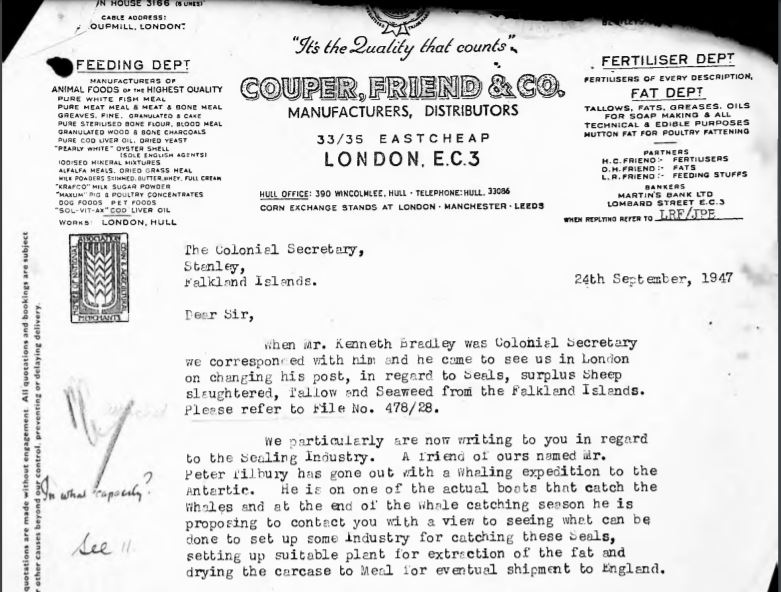
Sealing was not a new activity on the Falkland Islands, it had been going on since the whaling days in the 1800’s, probably even earlier, but this was clearly an attempt to reprise the 1930’s industry, looking a little deeper into the Falkland Islands Archive indicated the attempt had rattled someone in Whitehall as, behind the scenes, and at high altitude, there were hushed conversations taking place in the dark wood-paneled halls of office……..
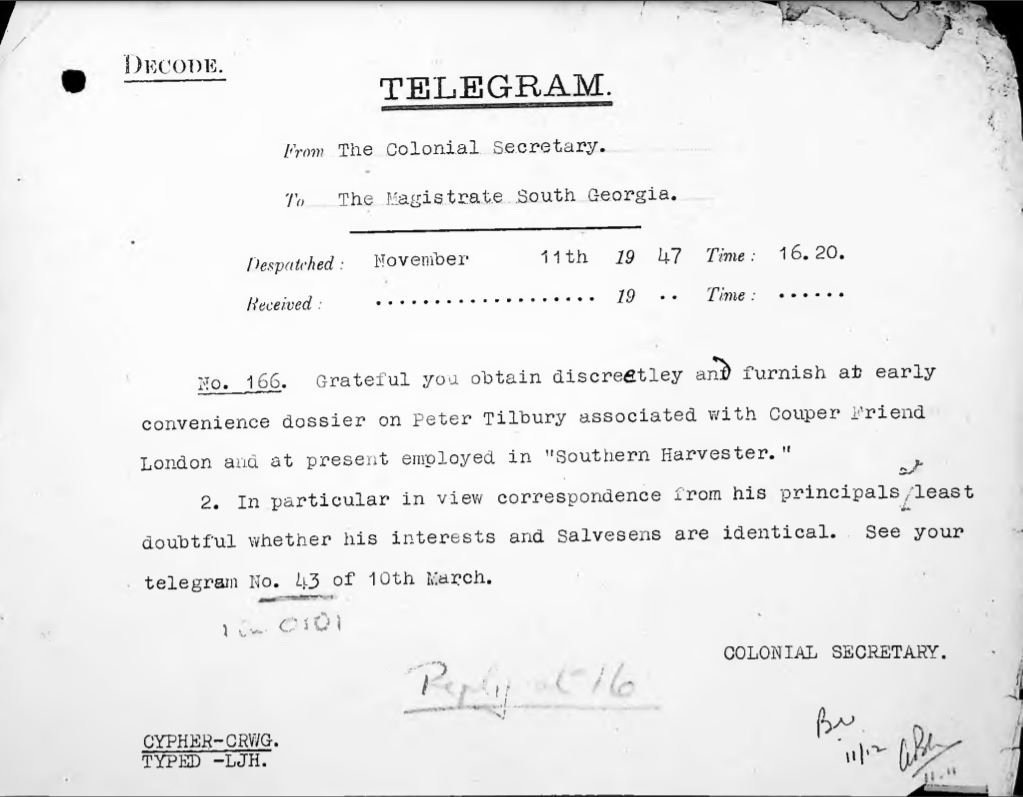
The series of letters & Telegrams (for those of you way younger than I am, that is basically an e-mail sent by telephone wires, specifically between two offices carrying special teletype machines, there was no internet in 1947….) between Couper Friend & Co, the Office of the Colonial Secretary and the Governor’s Office in Port Stanley are intriguing. There is clearly a conflict of interests between the Commonwealth Office, more inclined to give support to an application for sealing licenses to Salvessons (a Norwegian Whaling Company based in the UK but whaling in the South Atlantic out of South Georgia) or an Argentine concern, Pesca, than to Couper Friend & Co (A UK Animal Feeds Processing & Fertiliser Operation based in London), represented by Peter Tilbury (an employee of Salvessons on a whaler in the South Atlantic). It is very clear from the comments, often just handwritten in the margins of the letters and telegrams, that, what was written officially, was far from representative of what was going on in behind closed doors……..
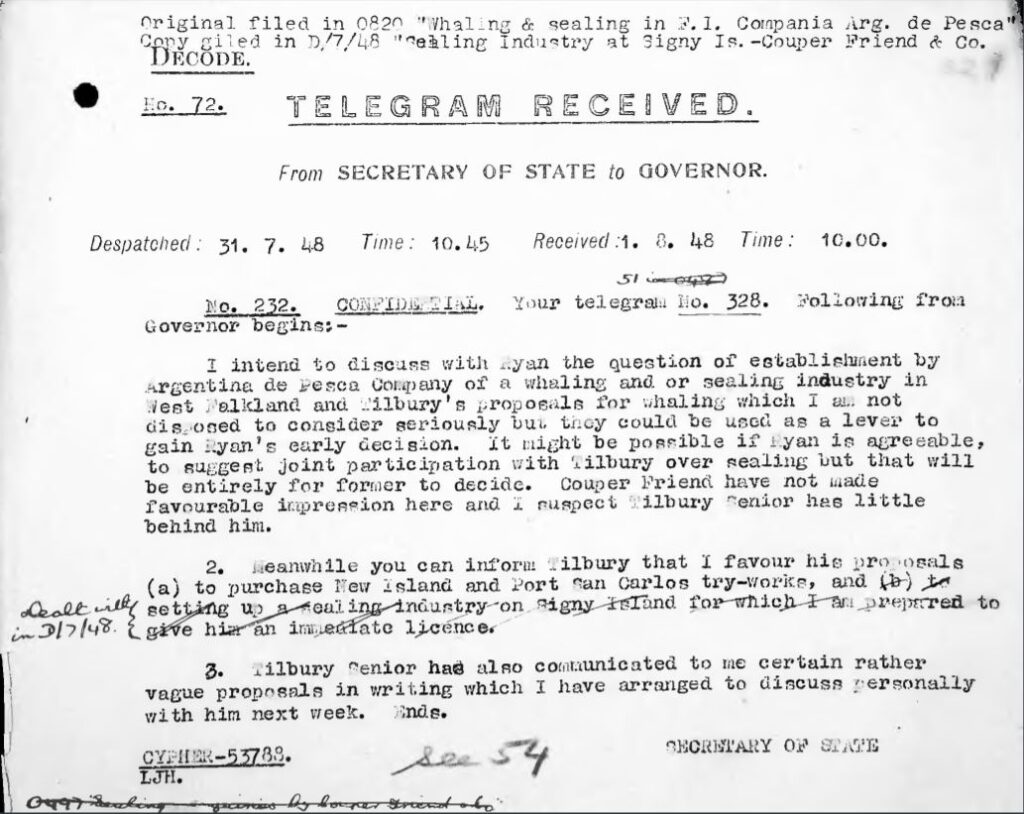
A little more on that perhaps later….but a look into parliamentary questions surfaced an interesting 1952 exchange: Hansard, the parliament archive (“Sealing Industry, Falkland Islands Volume 497: debated on Wednesday 19 March 1952” Online Resource https:// hansard.parliament.uk/Commons/1952-03-19/ debates/ 7bf26c69-a758-48ec-8ac 2-a212b301bdd2/ SealingIndustryFalklandIslands Accessed 02/01/2022) notes: “Captain Robert Ryder asked the Secretary of State for the Colonies to what extent the Governor of the Falkland Islands has granted licences for sealing in Falkland Island waters; and what is the state of this industry. Mr. Lyttelton (Responding) A licence to take seals has been granted in the Falkland Islands to the South Atlantic Sealing Company, Ltd., a subsidiary of the Colonial Development Corporation, and in South Georgia to the Compania Argentina de Pesca. Operations by the former company have been temporarily suspended owing to a dispute about the validity of the licence granted to them, but I understand that a settlement of the dispute is now in sight. In South Georgia results have been satisfactory” Clearly, by 1952 the issues surrounding Peter Tilbury and the British Government had been resolved, the intervention of the Colonial Development Corporation in support of Couper Friend & Co, and Peter Tilbury, had swayed the issue of licenses away from Norwegian or Argentinian influence
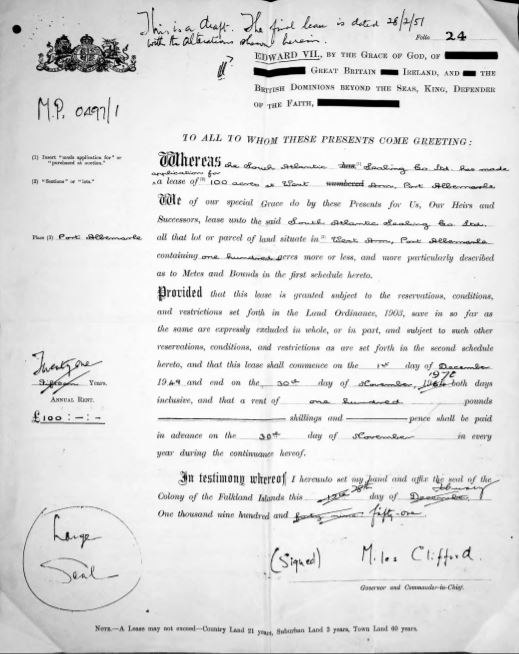
This would not be the last time the Government of the Falkland Islands interfered in those influencing the destiny of the Protector III, but let’s look at her time in the Falkland Islands and see where, and what, her duties were between her arrival in 1949, at Port Stanley, and her beaching in New Island…… Evidence of the need for a vessel for the South Atlantic Sealing Company had been contained within their business proposal to the Governor in 1948, a particularly specific vessel type had already been indicated too….

So why, particularly, a LL Minesweeper (double L mine-sweeper) then? It is a very specific requirement and I can only determine it has something to do with the open stern on the MMS class vessels. I imagine the need for the removal of Seal carcasses from a wide-ranging area around Albermarle for eventual processing, and with each male weighing some 270 to 360Kg, there is no better means I can determine to effectively move them. I would expect Peter Tilbury would have known this, coming from a whaling background, and having completed at least one season in the South Atlantic with Salvesen’s on Southern Harvester, herself a stern-slip (open stern with drag lines and ramp for dragging whales aboard) vessel
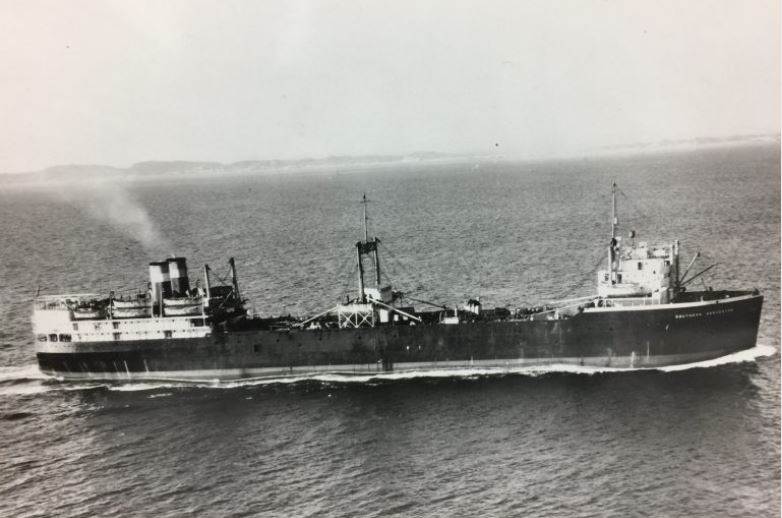
Whilst the far smaller Motorised Minesweepers of the MMS & Llewellyn Class were wooden ships, and never originally intended to be used in such a manner, fitting “…suitable deck winches..” would facilitate the dragging and, should a derrick or hoist be added, allow for the lifting aboard of large, and very heavy, Sealion & Elephant Seals, in order to bring them to the Albermarle processing factory. If the original LL winches had not been removed, and were still functional, it would make perfect sense to use an MMS class vessel for these purposes

There were several other documents shared by Tansy Bishop of the Jane Cameron National Archives, some relating to Protector III at various points in her career as a sealer, and then some repair work, there were crew lists for journeys, one to Montevideo with strict requirements from the Government, and a series of journeys between 20th March 1952 and a six month crew signing between 30th September of 1953, presumably expected to end 28th of February 1954, and finally documents concerning her disposal from the Colonial Development Corporation into private ownership and her eventual demise
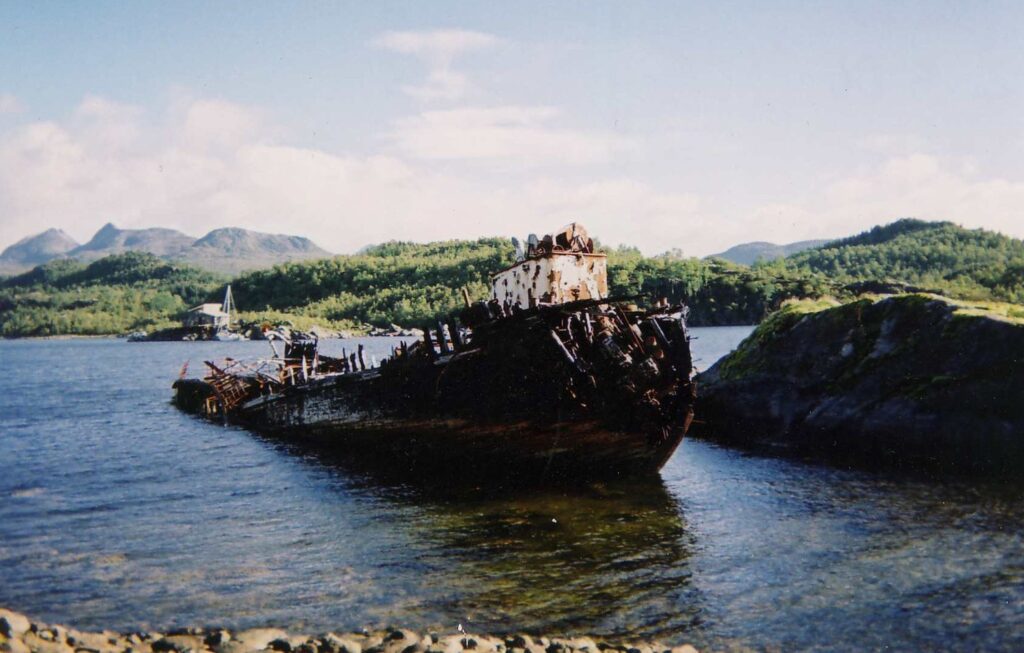
Around this time I also found that the Norwegian ship Harstad, sistership MMS 250 according to the Norwegian records, had ended up ashore in the Fjords which I believe, anecdotally, to be following the phasing out of licenses for wooden ships as passenger carriers by the Norwegian authorities. The Harstad had been overhauled by Danielsen’s in 1951, in 1956 it was again refurbished with a new aft deck, over a 3 month period, then in 1966 Harstad was bought by Jens Berklund for use as a Herring Salting plant. By 1969 she was owned by Hans Jensen and was, seemingly, abandoned in a very badly disrepaired state. Again there was no definitive proof in the details from Norway, that the Harstad was MMS 250, but it meant both vessels were hard aground in opposite hemispheres of the planet, it also showed that Harstad had fared considerably worse than Protector III from the photo of her badly ravaged hull
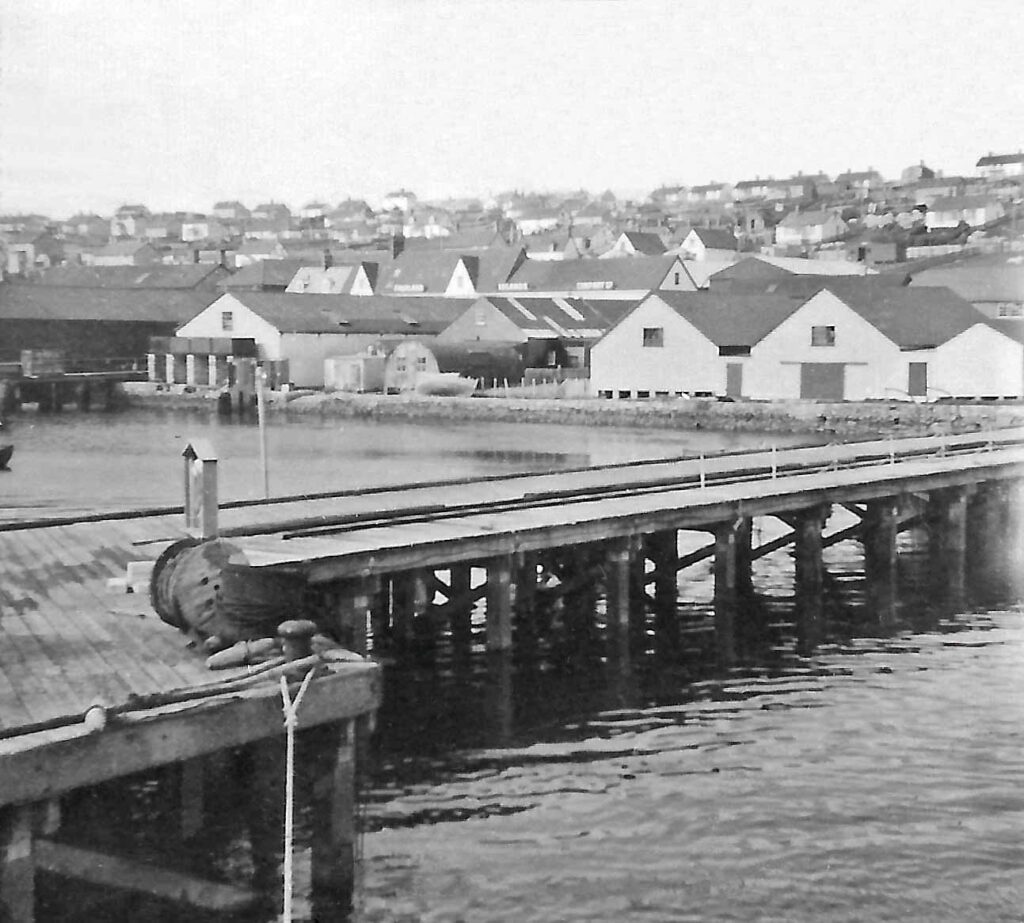
From her arrival in Port Stanley in November of 1949, Protector III was under the control of the South Atlantic Sealing Company and engaged in the setting up of the sealing enterprise initiated by Messrs. Couper Friend & Co and headed up locally by Peter Tilbury, journeys undertaken show the Protector III travelling again 24th of March in 1952, this time bound for Montevideo. Now the records available are those of the Falkland Islands Company, the Lloyds letting agents for shipping in the Falkland Islands, they do not record all journeys for all vessels (as far as I can determine from previous research for the wreck of the Castalia, another wreck on the blog), and Protector III may well have carried out many duties between Port Stanley and Albermarle. I believed the original stated intent to re-use everything at Albermarle was a failure, the equipment there (however much there remained from the 1930’s), was unusable, although I supposed the buildings might still have been used for the operation. It was not until I came across the autobiography of Richard Laws CBE (23/04/1926 to 07/10/2014, former Director of the British Antarctic Survey), that I found out a little more about Peter Tilbury, Protector III and sealing at Albermarle

I read an excerpt from “Large Animals and Wide Horizons: Adventures of a Biologist” whilst researching this piece and strongly recommend those interested in the Falkland Islands wildlife to do the same. Chapter 14, which I will quote from in a minute, is some 30 pages concerning a 1951 voyage on Protector III around the Islands surveying Sealion populations, but is far more than just that, it gives an insight into the Protector III, the weather, the remoteness and the lifestyles of the intrepid islanders: (Laws, R.M. “Large Animals and Wide Horizons: Adventures of a Biologist” Ch14. P314. Online Resource: https:// www.spri.cam.ac.uk/ resources/autobiographies/richardlaws/richardlaws1.pdf Accessed: 06/01/2022). On Richard’s arrival in Port Stanley P327:“I had arrived in Stanley early in January 1951. On arrival the Governor asked me to carry out a survey of the fur seal population in the islands, because the South Atlantic Sealing Company was having difficulty making a success of their sea lion operations” which begins to set the scene for the rather short-lived enterprise at Albermarle, but Richard goes on to describe the journey, which I won’t spoil here (It is great reading, I assure you), and occasionally the Protector III P328: “When I eventually got out to Albemarle I expected to travel around the islands in a small wooden vessel, the Protector and hoped to get down to Beauchêne Island” and sometimes Albermarle, P329: “….at Albemarle Harbour there was a former whaling station that had been refurbished as a sealing station, by the South Atlantic Sealing Company, with funding from the Colonial Development Corporation (CDC). Its Manager was a chap called Peter Tilbrook. The company had expected to make a success of the enterprise, which was based on killing sea lions for their oil”
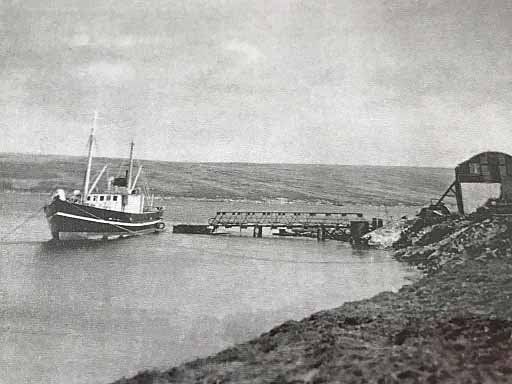
The comments on Protector III are insightful, she seems to have performed well in the torrid seas of the South Atlantic P334: “Weddell Island was by now only a few miles to the North, with rolling rather bleak hills, and large areas of screes and stone runs. There was a great tide rip, with foaming breakers to negotiate, abruptly demarcated from the smoother but shallow water on each side; in the rip were swirling cauldrons of ‘boiling’ water. Nevertheless the Protector made surprisingly good speed” I have cox’d Diving RIB’s around Weddell Island and, as those of you who have read the pieces on the Falkland Islands on this blog will know, the area is wild and untamed, Protector seems to have been well suited for the work!
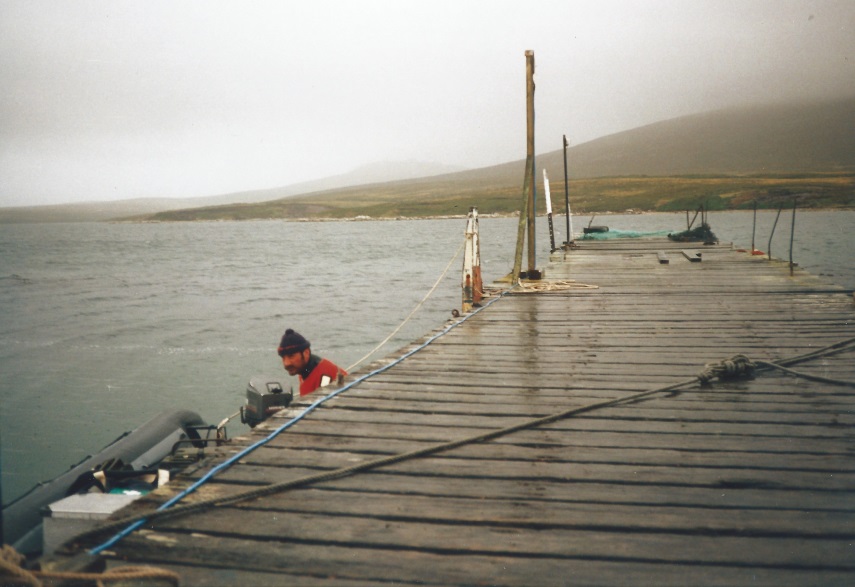
But there may have been an inkling of things to come buried in Richard’s piece too P338: “We unloaded the lambs and took on board ‘Remo’, Tilbury’s new horse – also hay for the horse and milk for us. I went ashore and got a couple of fox skins from Mr McGill. The Protector was touching bottom at the stern, where there was a ledge of rock, but we got her off with the engines” The plucky little minesweeper seems to have been a very capable workhorse, and despite the rough treatment of the South Atlantic, and its dangerous island headlands and islets, still performed impeccably P339: “The tide-race in Smylie Channel was very strongly against us and as it was relatively calm, formed into hundreds of small whirlpools about 6-10 feet across, with water bubbling up elsewhere. It was a most impressive experience and at times the Protector was almost standing still, even with her engines racing”

Richard Law’s Island odyssey was involved and widespread, it took him from the 17th of February to 06th March 1951, a trip of just over three weeks, although early on he had determined P332: “….it was 10.30 am before we slipped our moorings and steamed away against the southerly wind. I was beginning to realize that this was a general-purpose cruise, dedicated to making money, not to counting seals!” Although later in the chapter Richard is a little more understanding and perhaps forgiving of the circumstances of Peter Tilbury’s motives, and also points to the reason the venture was short-lived and unsuccessful P343: “…..Tilbury had been preoccupied with taking on miscellaneous contracts, in order to raise money. This was perhaps not surprising. The sealing venture was not founded in reality. Our voyage had shown me that neither the sea lions nor the fur seals were as abundant as people had thought. With considerable extrapolation, I estimated a total fur seal population of 14,000, and I did not recommend to the Governor that he should issue a license to the company”

It would be hard to blame Peter Tilbury for the overestimation of the enterprise at Albermarle, as Richard Law states himself P329: “In this they had been encouraged by a report, apparently written by a desk-bound ‘scientist’ in Whitehall, who had never been near the islands – nor did he have any special knowledge of seals. The best knowledge available was based on the reports of Hamilton, the Government Naturalist, who had earlier been with the ‘Discovery’ Investigations and had published two substantial papers on the species in 1936 and 1939. He had carried out a detailed count of the total sea lion pup production and, applying the results of his work on the age structure of the population he had estimated that the total population numbered almost 400,000” Where a population of that size would have probably been profitable, the more accurate numbers identified by Richard Law’s survey and estimations meant such an undertaking was doomed to failure. It would take Ian Strange’s aerial survey of 1965 mentioned earlier in this piece, to ratify Richard Law’s assessment of the number of seals in the Falkland Islands population, Ian Strange came to precisely the same (14000) figure as Richard did in 1951. What is available next comes from the crew listings which were a legal requirement for all British shipping

Whatever the majority of work carried out between the 14th November 1949 and the 24th March 1952 will perhaps never be known, but the Montevideo trip was to undergo “extensive repairs to her rudder & engines” (Harbourmaster, Port Stanley F.I. in “M/V “Protector III.” ” a Letter in the Jane Cameron Archives “SHI-VES-13-6. Clearance of Protector III to Montevideo.pdf” Accessed: 04/01/2022). Following the repairs between 20/03/1952 and 09/05/1952 the Protector III returned to Port Stanley under the command of Peter Tilbury and clearly continued her work. The quality of the repairs seem to have been unsatisfactory to say the least, as para 3 of the same letter goes on to say “On Monday 8th. September, 1952 (Sealing Officers Diary) “Protector” was anchored at Barren Island where when trying to move in closer it was observed the Rudder had fallen off. H.M.S. “St. Austell Bay” went to her assistance and with the help of a diver the missing Rudder was located. On Wednesday 17th. September, 1952 at 8 a.m. the “St Austell Bay” arrived in Stanley with “Protector” in tow” Not a particularly good endorsement of the repair work in Montevideo, I am sure you would agree….
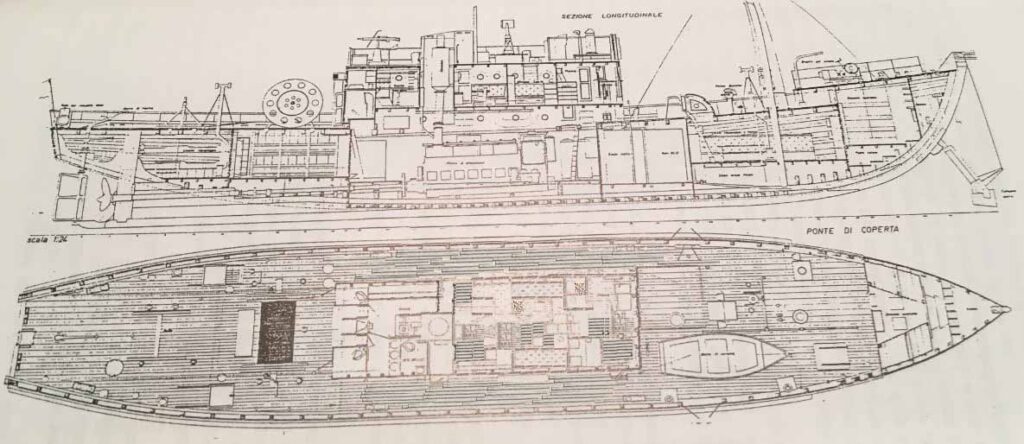
For a rudder to “fall off” requires consecutive or spontaneous failures at multiple points, the shaft connecting the rudder must pass through the hull and be connected to the steering assembly, this involves support at the base of the rudder which would be nuts, bearings & shims either side of the support strut, and then the same arrangement at the underside of the hull and inner hull side to prevent water ingress but facilitate rotational movement in order to steer. There would also be the connection to whatever arrangement was used to turn the rudder, usually a quadrant and chain or connecting rods of sorts, again usually screwed together with nuts & washers at 3 points or more for such an arrangement. I find it odd in the extreme that such an assembly was deemed to have fallen off, it seems even more strange that repairs had been recently carried out, ship repairs are seldom undertaken by inexperienced or unqualified technicians…….
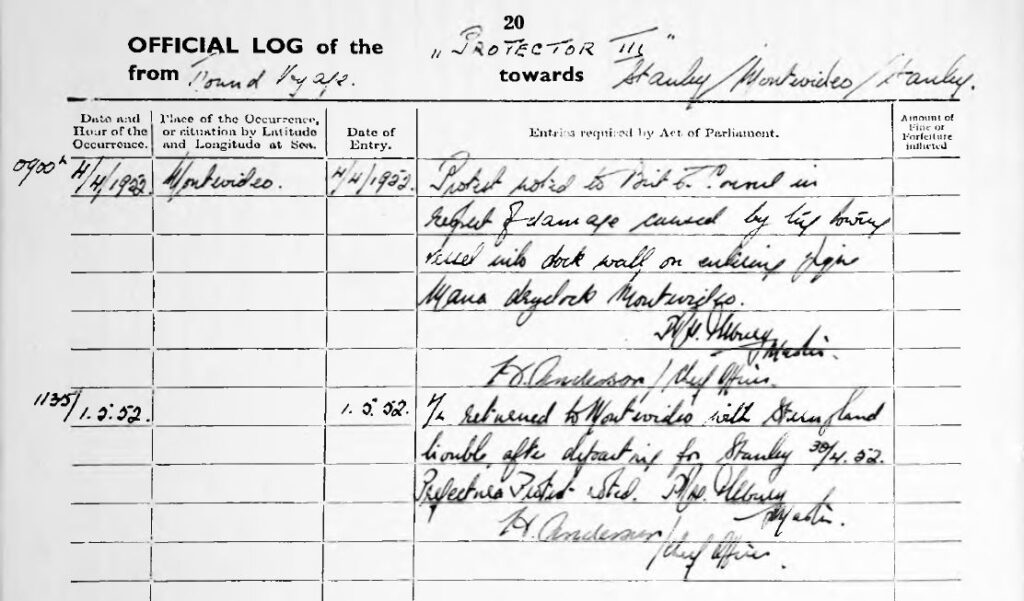
The Jane Cameron National Archives may have part of the answer to the Rudder Issue Protector III experienced in September of 1952, the Log Book contains details surrounding an earlier departure from Montevideo on the 30th of April, “…returned to Montevideo with stern gland trouble, after departing 30/04.52…..” The stern gland is the aperture through the hull where the propeller shaft passes through seals into the vessel and to the transmission & Engine, the detail is once again not explicit, it “could” have also been used as a term for the rudder gland. Both are areas where sealing to prevent water ingress is critical, leaks at these points have sunk vessels many times. So it would seem whatever repairs were carried out in that area in Montevideo, were not without issue
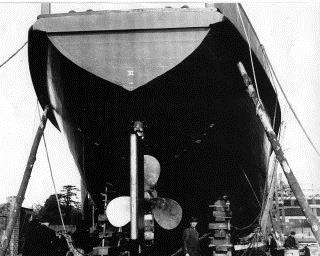
The Harbourmaster’s letter (Harbourmaster, Port Stanley F.I. in “M/V “Protector III.” ” a Letter in the Jane Cameron Archives “SHI-VES-13-6. Clearance of Protector III to Montevideo.pdf” Para5. Accessed: 04/01/2022) indicates a second repair by the Falkland Islands Company was more successful ““Protector” was fitted with a new rudder made by the F.I.C. and shipped at Government Jetty, she continued in the service of the Sealing Company until 9th. March, 1953”What is not apparent in the Harbourmaster’s letter is that plans were already well underway, between the South Atlantic Sealing Company and the Commonwealth Development Corporation, to sell the Protector III, and those plans were (perhaps quite naturally), once more of some concern to those haunting the corridors of Whitehall……
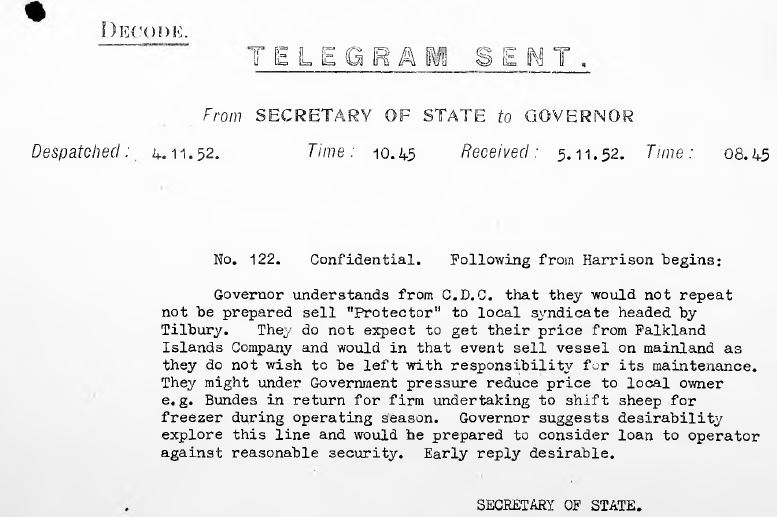
It took some time to reach a decision on exactly who could and could not be approved for the sale of Protector III, but once again Peter Tilbury seems to have managed to calm the waters, and ends up in a consortia that eventually (March 1953) purchase the Protector III from the Colonial Development Corporation. However that was not before she was inspected and confirmed as in good general condition by the crew of HMS St Austell Bay (October 1952), perhaps the repairs to her rudder were finally behind her…… It seemed the Protector was getting back in the swing of things, as the Harbourmaster goes on to remark: “On the 9th March, 1953 at 3p.m. the “Protector” changed owners by Bill of Sale to the Intercoastal Trading Company Limited of this Port.”. The Protector III’s Log shows her taking on crew in March of 1953 for a six month period for a “Voyage within Falkland Islands home trade limits for a period of 6 months” with Peter Tilbury as Captain under the ownership of The Intercoastal Trading Company:
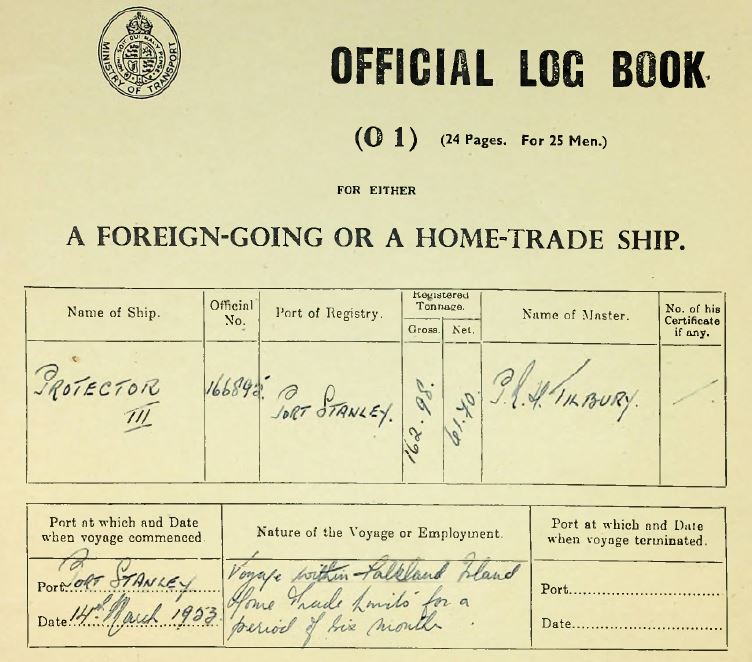
At this point I had found another break, “The Intercoastal Trading Company” of Port Stanley, and this small piece of information gave me a lead in the Falkland Islands Biography section, a Mr John James Davis (1893-1969). John Davis was one of 10 children, born on the 30th January 1893, into a Falkland Islands family in Port Stanley and followed his father, a sail-maker with the Falkland Islands Company, into a career in sailing vessels. John Davis (Allan, J. & Cameron, J. “Dictionary of Falklands Biography. Davis, John James (Cracker) 1893-1969” Online Resource: https:// www.falklandsbiographies.org/ biographies/ davis_john1 Accessed: 05/01/2022) had several commands from as early as 1917, when John would have been just 24 years old, including the cutters Indiana and Paloma, the ex-pilot boat Penguin and the Ketch Perfecto Garcia. John took work ferrying supplies & cargo between the islands and “working the tussac islands”, which I take to mean work moving sheep around (John had a flock of some 700 sheep & rented Hummock Island in the 1930’s to graze them) to take best advantage of the grazing on various islands seasonally. John became a part of the Intercoastal Trading Company in 1953, (as a shareholder, John is not on any crew list I have seen) as they purchased the Protector III from the South Atlantic Sealing Company (Colonial Development Corporation). In a twist of irony John Davis had captained the sealing vessel Port Richard (later known as the Afterglow) in the early 1930s for the Falkland Islands Sealing Company working at Albemarle
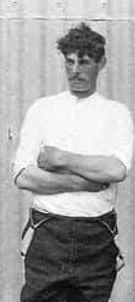
John or, as most Falkland Islanders seem to have known him, “Jack” (and more often by his own use “Cracker Jack” or just “Cracker”) is described as “….the last of the Falklands pirates, famous for flying the Jolly Roger from the masthead of vessels under his command” and was by all accounts a larger than life character, I strongly suggest any reader of this piece looks him up on the falklandsbiographies.org site, they don’t make them like John Davis anymore! It is with John Davis that final closure can be given to the Protector III and that her resting place on New Island can be understood, John had purchased New Island from George Scott in 1949 to farm and, presumably, graze his sheep. The Intercoastal Trading Company was a somewhat short lived venture, evidenced by the Harbourmaster’s letter “The vessel entered in the Coastal Trade of the Colony from March, 1953 to September, 1954 when the Company considered her a non paying proposition and she was put to anchor….”. It didn’t take long for the Protector III to put to sea again, this time undoubtedly to the annoyance of the Master of the HMS St Austell bay, whose evening plans were clearly disrupted……
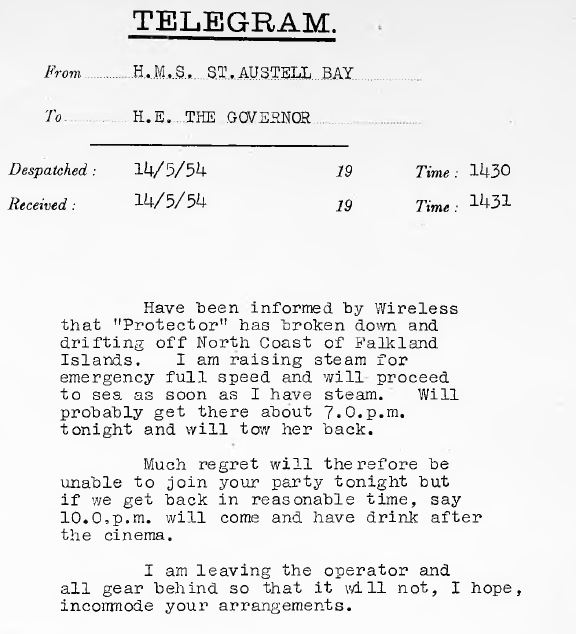
The final puzzle piece falls into place with a comment from John James Davis biography “When the Intercoastal Trading Company was dissolved in 1954, Jack also became the sole owner of Protector III, but could not afford engine repair costs. In the early 1960s, he arranged for the Philomel to tow her to New Island, where she still lies beached in the harbour below the settlement”. I recalled a comment made in an e-mail to me, from Robert Rowlands, concerning the Protector III’s Engine condition: “……the guy who used to run the engine for him whilst she lay in Stanley did not prime the lube system with any pressure in advance of starting and of course it ruined the crankshaft bearings which ended her career and she was towed to New Island by an ex Admiralty MFV in 1969”. The final ignominious act of the Protector III and the reason she sits forlornly in the bay at New Island, lies at the feet of the Government of the Falkland Islands, more specifically the Harbourmaster (“Grierson, W.J. 1536. 16th April, 64”. Item 34. the Jane Cameron National Archives “SHI-VES-13-5. Disposal of mfv Protector III.pdf” Accessed 05/01/2022) who wrote to John Davis in 1964 saying “……The Sealer “Protector” which is at present lying in Stanley Harbour is being heavily buffeted by wind and I feel that she should be moved to a less vulnerable anchorage.”

So….I started with a question in the back of my mind, based on the information sent by Robert Rowlands just before Christmas of 2021…. “Is Protector III the Motorised Minesweeper MMS251” I have searched every archive I can, and found everything I believe is there to find. The search was not helped initially as the records for Protector III are buried in the National Archives filed along with “Ship Lamia”, for some reason that perhaps only an archivist would understand, and I am far from that, as I am sure you will have realised by now! I received the records in February of 2022 and they are ambiguous, the vessel is already called Protector III in 1947, at the time of her sale to the Eastern Sea Fisheries Joint Committee, and further enquiries into Protector III with Kings Lynn Port and their archives initially came up empty, as have enquiries to Wyvenhoe, the MoD/Navy sales port for the disposal of MMS250 & MMS251. The official number for Protector III, 166895, doesn’t bring anything more to the party I’m afraid either, as a search on that number gives the same 1947 and later years information
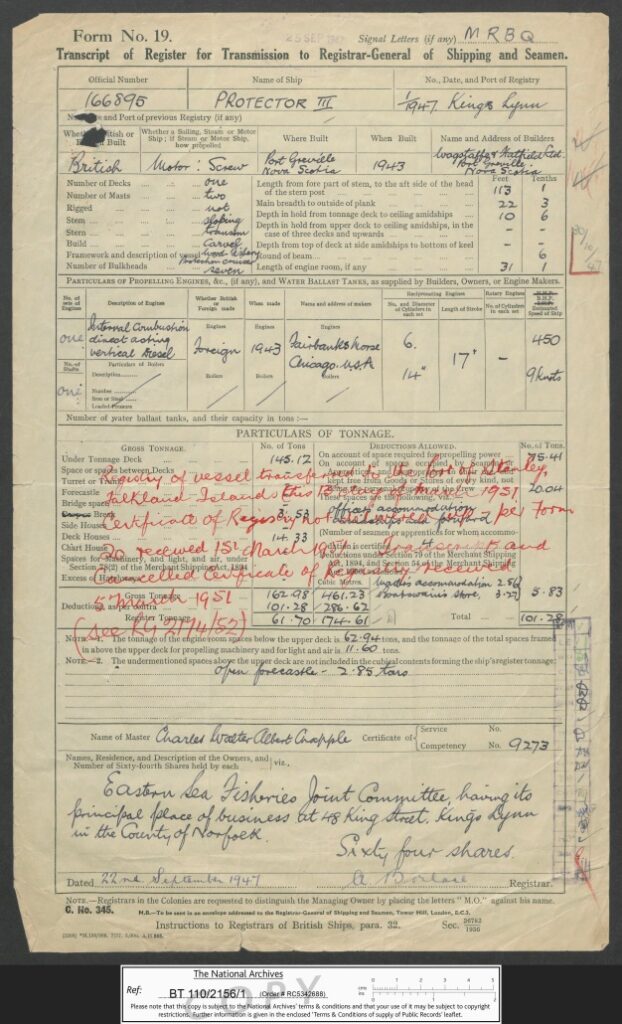
One surprising turn-out from the registration is the Master of Protector III, on her sale to Eastern sea Fisheries, a Master Mariner named Charles Walter Albert Chapple, now those of you who have read the piece on HMT Elk on this blog will perhaps recall that name? Charles Chapple is a distinguished Captain amongst those of the Minesweeping Fleets having served in both WWI and as Master of HMT Elk in World War II, indeed in 1940 he wins the Distinguished Service Cross, (second only to the Victoria Cross) for services to Minesweeping. Charles Chapple and his crew would trap and successfully recover a new kind of German mine whilst sweeping off the North East coast (it would turn out to be the first ever of a type of acoustic mine, and be defused by the specialists at HMS Vernon, the minesweeping command), and result in the development of the Kango acoustic hammer (designed by the Keyham Engineering College of Plymouth), mentioned earlier in this piece. HMT Elk was lost whilst trialing an “experimental steam powered anti mine device” likely an early version of the Kango mounted in the front hold of the little trawler, luckily, on that occasion all her crew survived
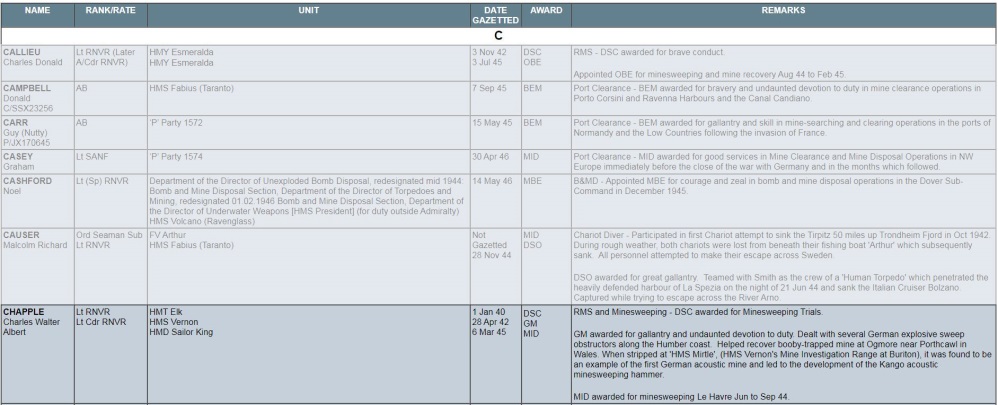
I was convinced I had missed something….somewhere…..and was determined to take another shot in the various archives I felt she might still be hidden away, (somewhat spurred by the information on Protector III discovered in the National Archives under the “Ship Lamia” file) before reaching any conclusion on the Protector III. I took another look at the on-line catalogue for the Norfolk Record Office and found the catalogue reference (P/SHL/14) for vessel registrations in 1947, whilst there were no on-line catalogues to look through, when I sent the access request in to Jenny Watts the Senior Archivist at the Norfolk Records Office, they were happy to agree a search of that register, and that came back with Protector III as the very first entry for 1947…..Why had nothing been found beforehand?….who knows, change of personnel, change of search reference, missed by accident…it didn’t matter, I now had a two-page entry and it might just have been a second Christmas for the level of excitement and anticipation that generated!

I could barely contain the excitement when the PDF’s arrived 10 days later from Chloe, the researcher at the Norfolk Records Office, and I pored over both photos for anything that might categorically confirm MMS251 was registered as Protector III…..nothing, not a single specific to go on, no serial number against her engine, nor anything meaningful against her description “….wood. Fishery protection cruiser”……. I was disappointed to say the least, had she been a German vessel there would have been all the detail needed…..but she was British, made in Canada……and it was just my luck, just another teasing frustration in the story and history of Protector III……

There is one more piece that might serve to define Protector III as MMS251, a mention in the commsmuseum site publication in regards to her pennant, now a vessels pennant (from “pendant”) is how she would have been recognised prior to 1948 whilst in service. Looking up MMS251’s designated pennant gave me J751, the letter is her class designation and that (J) was “Minesweeper”. Looking up the assigned pennant numbers shows a sequential numerical from MMS17 which carries the pennant J517, so a simple progression takes MMS251 to pennant number J751

That pennant is also registered to MMS251 in David Shirlaw’s book The Arsenal of the North, however that is the conflicting source of sale to Harstad in 1947, the point to note there is that there is no anomaly between MMS250 (pennant J750) and MMS251 (pennant J751) in the sale notification

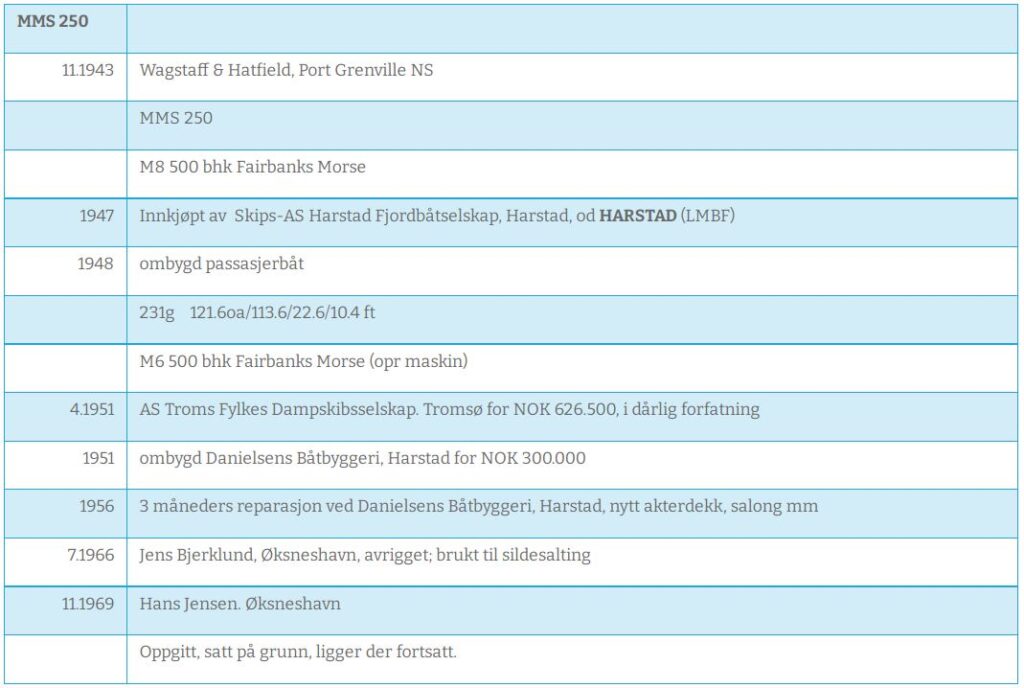
With the Skipet register for the Harstad clearly identifying MMS250 as the vessel sold to Norway the evidence is becoming compelling, at least circumstantially, that the vessel known as Protector III now lying in Coffin Bay on New Island in the Falkland Islands is almost certainly MMS251. Is this conclusive……no, it isn’t, I had come to the conclusion the only person who might ever answer the question absolutely is Robert Rowlands….. and I eagerly awaited his visit to New Island which could “categorically” state that she is either MMS250 or MMS251. I personally was convinced, by weight of probability alone, that Protector III is MMS251, and up to February of 2022 I had been unable to find “proof absolute” that she is….. believing it might not even exist, should the engine serial number have been removed or eroded from the heroic (and very likely, last of her kind), little vessel, abandoned, thanklessly at the ends of the Earth………………
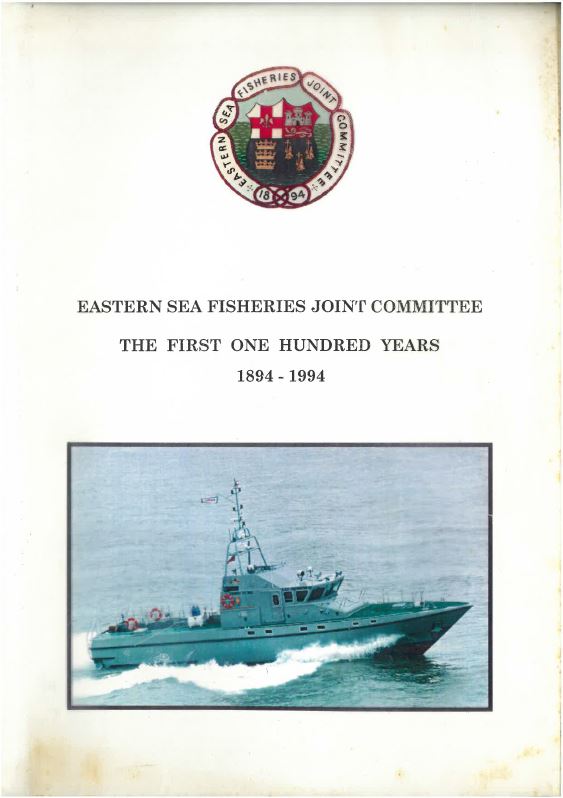
But then I had a stroke of luck, finally…… The request I had made to the Eastern Inshore Fisheries and Conservation Authority (the inheritors of the purchase of Protector III, then in their guise as the Eastern Sea Fisheries Joint Committee, which existed between 1894 and 1994 before becoming what is now “Eastern-ifca”), had been picked up by Jon Butler, their Head of Operations, who had kindly shared an internal piece written in commemoration of “The First One hundred Years of Fisheries Management Protection” printed in 1994 (The cover of which co-incidentally showed ESF Protector III, their current 1994 Fisheries Protection Vessel). The document had been saved in the personal collection of Eastern-ifca’s Admin Officer, Jodi Hammond, to whom history should be eternally grateful! The commemorative piece details Norfolk’s coastal fisheries activities and successes and explores their one hundred year fisheries protection history………and there it was……..writ large on page 12, incontrovertible evidence that meant I would finally be able to conclude this search. It transpired that the original “SS Protector”, employed by the Eastern Sea Fisheries District as a fisheries protection vessel (from its construction at Bridge Dockyard, Sunderland, by Robert Thompson & Sons and launched in August of 1899), had been replaced in 1903 (by a vessel built at Greenock by George Brown & Co), and had served between 1904 and the second world war, when the vessel was requisitioned for service, re-named HMS Thalia, and put to service as a minesweeper, sadly she was lost in a collision in Loch Linnhe, Scotland in 1942
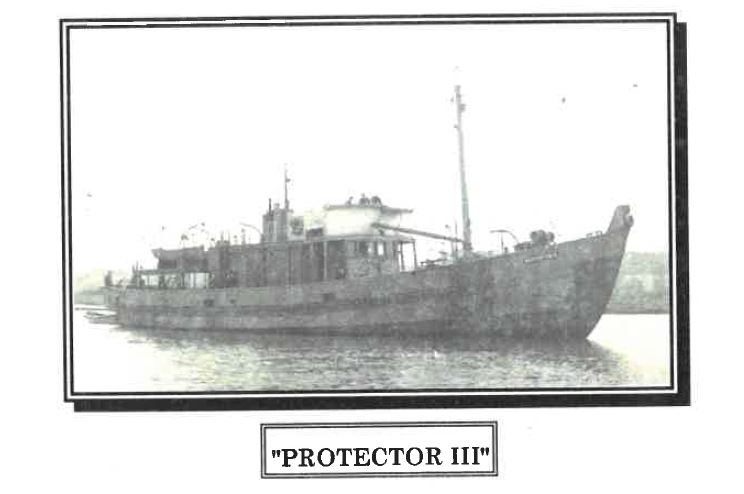
The conclusive proof that Protector III is MMS251 is contained within a brief but concise paragraph in the Eastern Sea Fisheries Joint Committee publication “The First One Hundred Years 1894 – 1994” beautifully illustrated with the third of her name “Protector III” and states:
“When the war ended, it became imperative that a replacement be sought for the late “Protector” and Mr. Grice [now titled Chief Fishery Officer] set about investigating possibilities. His search was successful and the committee agreed to his recommendation that Motor Mine Sweeper No. 251 be purchased from the Director of Small Craft Disposals, Admiralty. It was minuted at the Joint Committee Meeting held in King’s Lynn on the 1st. of August 1946 that the recently acquired Fishery Protection Vessel be named “PROTECTOR III” and that she would be based in King’s Lynn.”
There is no ambiguity in the statement, it is categoric: “….that Motor Mine Sweeper No. 251 be purchased…” why so adamant, who knows, but it is clear……. and……. at last, final
Protector III, lying in Coffin Bay on New Island, in The Falkland Islands of the South Atlantic Ocean is MMS251!

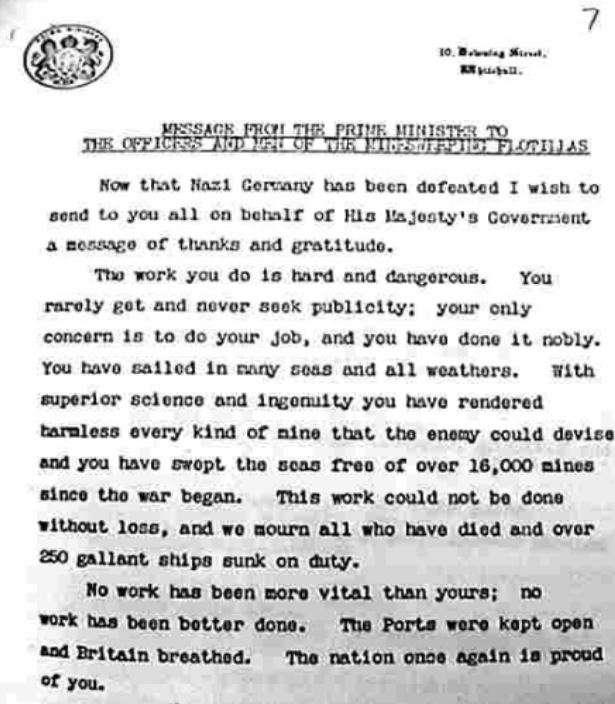

As ever, I am deeply indebted to those who have assisted in this piece and grateful for their help with information, photographs and research: Robert Rowlands (The Falkland Collection), Tansy Bishop (The Jane Cameron National Archives F.I.), John Collins (Nottage Maritime Institute), Ashlyn Prasad (Vancouver Maritime Museum), Oralee O’Byrne (Age of Sail Museum) Jeff manning (Swansea Docks History), Ian Palfrey & Alison Bernard (Norfolk Record Office) John Jones (Wildfire III), Peter Hill (Wyvenhoe History), Gunnar Oversen, Jenny Watts (Senior Archivist, Norfolk Records Office), Chloe Van Roose (Norfolk Records Office), Jon Butler (Eastern-ifca), Jodi Hammond (Eastern-ifca) and, finally, the Minewarfare & Clearance Diving Officers Association (MCDOA)
And, of course, to those who “old age and senility” have made me miss from the credits above, and to whom I apologise most profoundly!

I find this all very interesting just having been sent it by a fellow enthusiast of ships and shipping.
Robert Rowlands had forwarded this to me some time ago (I am also a Falkland Islander) I remember the Protector II as a working ship. During my salvage career I also worked on an identical vessel but built in U.K. “Topmast 17” for Risdon Beazley Marine..
There are two more identical vessels sunk at mooring in Leith Harbour South Georgia in the Antarctic from Christian Salvesen namely Southern Peter & Southern Paul.
I did send Robert full details and pictures of the 3 sisters.
Lyle. Craigie-Halkett
Lyle, I’m pleased you have found the piece of interest and nice to make the acquaintance of someone who worked for such an iconic company too. If the identical MMS’s are still intact albeit underwater than I believe they are likely to be the only vessels of their type left, as the last of Protector’s type was burned beyond salvage during restoration as far as my information goes. I’d be very interested to see the pictures you sent Robert if you wouldn’t mind sharing? My personal e-mail is colinj@talktalk.net and I am currently at MPA on a contract for a couple of years if you ever fancy a beer?
Thanks for getting in touch & best Regards
Colinj